












Dear Readers
We, at Rotary News, have been bringing you the magazine without increasing the price from 2011. In fact, in 2014, the annual subscription was reduced from `480 to `420. As cost of paper, other inputs and administrative expenses are constantly rising, the RNT Board has decided to increase the subscription price by a mere `5 every month — from `35 to `40 per copy.
So the annual subscription dues for Rotary News (English, Hindi and Tamil) will go up from `420 — a figure several Rotarians disliked! — to `480 for every member, effective from July 2022.
The annual subscription for the E-version now goes up from `360 to `420 from July 2022.
We seek your cooperation and compliance.
Editor











Subscriptions can be made online


Name Rotary News Trust Bank

HDFC Bank, Montieth Road Egmore, Chennai
SB A/c No 50100213133460 IFSC
HDFC0003820
After the transfer of funds, please share by email or WhatsApp the UTR number, club name, president/secretary’s name, amount and date of transfer.
Our email id rotarynews@rosaonline.org
WhatsApp 9840078074
The subscription form can be downloaded from https://rotarynewsonline.org/ wp-content/uploads/2022/01/SubscriptionForm-22-23.pdf

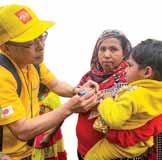

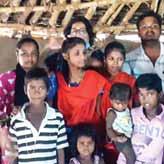
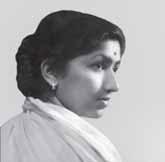


12 Pakistan crosses a major milestone - 1 year without a wild polio case
Fighting Taliban and other challenges, Pakistan marks an entire year in January 2022 without reporting a single wild poliovirus case.
24 Jalna Rotarians pull off a medical mission in the pandemic
673 people were surgically treated at this 7-day mega medical camp in Jalna.
32 RCCs on a service spree in Bengaluru
Rotary Community Corps pitch in with meaningful service projects across boundaries.
40 RC Madras Midtown turns 50 with a flourish and its future plans.
44 The nightingale falls silent
A farewell to the music legend Lata Mangeshkar whose legacy lives on.
54 Rotarians visit Kartarpur Sahib Gurudwara
A delegation from RC Mansa Royal enjoyed interacting with Rotarians of Pakistan during their visit to the gurudwara in Pakistan.
60 Muzaffarnagar Rotarians gung-ho on literacy and children.
62 RC Pune South holds soy milk workshops for rural women
The club has taught women in 11 villages to make protein-rich soy milk, a boon for malnourished children.


Welcoming price hike for a “treasure trove” magazine
The announcement in the February issue of a meagre price hike in the subscription of Rotary News, after 11 years by only `5 a copy is welcome. This cannot be considered as a burden at all for Rotarians, who love to read the magazine for its distinct personality as the journal is extremely good and reflects positive Rotary values through wide coverage on service projects. The magazine is a treasure house of ideas, inspirations and opinions. Rotarians are motivated every month by reading
ARotary message through a Rose Float during the parade held to mark new year’s day at New York will surely help build awareness about Rotary and its theme. The cover photo exhibits the good work of RC Rourkela.
Glad to know that the nationwide blood glucose testing camp on World Heart Day was a success. As explained by the editor, waterwheels will be a novel idea for future generations.
RID Mahesh Kotbagi’s ideas are noteworthy in empowering girls to become women with vision. Focusing on

the messages of RI leaders and they also come to know about the various club activities in our country. Most important, the chronicling of service projects from different
public image of Rotary which can attract new members as pointed out by RID Venkatesh is the right strategy. Messages from TRF Trustee Chair and TRF Trustee are informative.
The interesting feature on LN4 prosthetic hands and Rourkela Rotarians’ involvement in providing them to the needy is loaded with information. Happy to learn that RC Calcutta has built a school in Darjeeling. The feature on playback singer TM Soundararajan takes us back to the golden days of the past where film music was enjoyed by all.
parts of the country is noteworthy.
It is a pleasure for Rotarians to subscribe to this magazine and get the best Rotary exposure every month. Incidentally, we came to know the presidential theme of RIPE Jennifer Jones, Imagine Rotary, through our magazine. Her request to all Rotarians to imagine the possibilities in the change they can make to transform the world is inspiring.
R Srinivasan
RC Madurai Midtown — D 3000
Articles like Rotary saves yet another child, Waterwheels to the rescue of women, TRF grants:bane or boon, Project Vignettes, and Uttarakhand school back on track with Rotary gifts, are all informative. Congrats to the editorial team.
Philip Mulappone MT RC Trivandrum Suburban D 3211
Thank you for writing about our project Arivu in Rotary News The article has increased our responsibility.
Frankly, we were not aware that this is such a good project which would attract your attention till
you called and expressed your interest. We started this with a natural instinct to support the rural students. We, the Team Arivu of RC Puttur Central, along with all the members of our club are grateful for your support. Even though we are just three years old, every year we take up long-term projects. We are very happy with these projects, hence thought of sharing with you and we will continue to do so in future too.
B Sanath Rai, RC Puttur Central — D 3181
Iloved the idea shared by RI President Shekhar Mehta on Rotary’s Days of Service. It is a great PR exercise to showcase our projects. The power of many clubs highlighting a common theme builds trust among the people to join hands in their quest to do good to society.
RID Mahesh Kotbagi has asked us to empower girls and our club is doing exactly that this year. Our Project Red is empowering the girls through MHM sessions. We intend to impact the lives of at least 4,000 girls this year.
The projects covered in the magazine are diverse each month. The cyclothon project by RC Bharuch is inspiring.
I also loved the way Mahabs institute was covered with detail. RIPE Jennifer Jones has come out with her presidential theme Imagine Rotary These two words have a much deeper meaning.
Vivek Khandelwal RC Deonar — D 3141
Whenwe think of playback singer TM Soundararajan, our mind also conjures up images of lyricists Kannadasan, Vaali, musician duo MS Viswanathan-Ramamurthy and composer KV Mahadevan, as they all have created a niche for themselves in the Tamil filmdom. You should have published their pictures too in the article, TMS, the singer of hope, a well-written and interesting article.
Dr Subramanian RC Puliyangudi — D 3212
Ihave been a regular subscriber of Rotary News . I have, in my library, almost all the copies of this wonderful monthly journal.
The January edition has been a special one. RI President Mehta has written a wonderful piece titled Use your vocation to change lives . His enumeration of Rotary’s work in India is worth three cheers. For years I have been looking for
a catchy compilation of such content but could not find it. It is for the first time that we have in front of us a one-page-summary of the great work we Rotarians have been doing in India. Thank you, Rasheeda for bringing this to print. A very nice coverage on the most visible portion of the page. I have pasted its snapshot on my desk board for all to read and feel proud.
Vipan Bahl, RC Jaipur Bapu Nagar — D 3054
The article on CoL was well-reported, covering all aspects of the council presented by Rotary leaders in the Jan issue. Rotarians pay $1 as annual fees to fund and participate in the CoL. RC Rasipuram proposed a resolution to acknowledge the role and responsibilities of district secretaries at one of the CoL sessions which was adopted with 70 per cent of votes. I request the RI board to frame curriculum on the roles and responsibilities of district secretaries so that they can be trained appropriately.
Ramaswamy NP RC Rasipuram — D 2982
RI President Mehta has urged Rotarians to use their vocation to change lives and true to this suggestion, they have
built 500 houses as part of tsunami-relief effort. He also wants us to do something of value for the poorest each month to improve their livelihood.
Congrats to Editor Rasheeda Bhagat and her team for coming out with the issue in time without missing even once during the peak of the Covid pandemic. The entire team is doing an excellent job and I pray to god to give you good health to continue your work.
S Muniandi, RC Dindigul Fort — D 3000
Durgapur ready for Sanjeevani Hospital
Your article Mending Little Hearts, the Sanjeevani Way (Oct issue) gave me a new light and inspiration to stretch beyond and do more for the community. The last paragraph says that
the trustees are looking for a city in Eastern UP or Bengal, Bihar and Jharkhand. I suggest to them to set up such a centre in Durgapur which has emerged as an educational and medical hub of the eastern region because of its connectivity. All the hospitals here serve patients from Bihar, Jharkhand, North East and some parts of UP.
I would like to be instrumental in helping acquire land either free or at a nominal cost and try to assist them in setting up the Sanjeevani Hospital. Our district has completed over 300 congenital heart surgeries through a Global Grant Project Heart to Heart a couple of years back.
Amit Kumar Sharma RC Durgapur Smart City — D 3240
We welcome your feedback.Write to the Editor: rotarynews@rosaonline.org; rushbhagat@gmail.com.
Mail your project details,along with hi-res photos, to rotarynewsmagazine@gmail.com.
Messages on your club/district projects, information and links on zoom meetings/webinar should be sent only by e-mail to the Editor at rushbhagat@gmail.com or rotarynewsmagazine@gmail.com. WHATSAPP MESSAGES WILL NOT BE ENTERTAINED.
Click on Rotary News Plus on our website www.rotarynewsonline.org to readabout more Rotary projects.
Greetings, dear changemakers of Rotary,
We have overcome so many challenges these past two years and changed many lives. It brings me great joy that we have worked so hard this year to grow Rotary through the Each One, Bring One initiative. The result has been excellent membership growth. Let us keep up the momentum.
On March 11, 2020, the World Health Organisation declared that Covid-19 constituted a pandemic. Two years later it is important that we continue to draw on our expertise in disease prevention and treatment to help people worldwide cope with the continuing challenges. The pandemic continues to defy all expectations, but we cannot be frozen in fear. Our work is too important. It is also important that we make time for each other, and I urge you to register for the Rotary International Convention 2022 in Houston.

We can continue to build hope and spread peace by using our resources to help the most vulnerable. The pandemic has had an especially devastating impact on girls; on its first anniversary, Henrietta Fore, the executive director of UNICEF, said that “immediate action is needed to mitigate the toll on girls and their families.” This need remains just as strong a year later. The pandemic has affected girls in unique ways — stunting their
educational attainment, weakening their job prospects and contributing to other terrible results such as child marriages and increased human trafficking.
Data from UNICEF reveals why our action is so essential. In the 2010s, important progress was made toward eliminating the practice of child marriage, and UNICEF estimates that 25 million such marriages were averted worldwide. Unfortunately, the pandemic reversed those positive trends, and as a result an additional 10 million girls are vulnerable to becoming child brides by the end of this decade.

address the root causes of conflict around the world, setting the stage for sustainable peace.
None of us know how long the Covid-19 virus will linger — and as an organisation that has worked tirelessly for decades to eradicate polio, we understand better than most the difficult work that lies ahead. That is why we need to remain focused on what is possible — not feeling nostalgic for the way our lives were, but looking hopefully to a future that uses this opportunity to Serve to Change Lives. I look forward to continuing this good work with you.

This is why our focus on Empowering Girls is such vital work, and I am delighted that President-elect Jennifer Jones has committed to continuing this initiative. In my travels, I have witnessed many wonderful examples of club projects that back our Empowering Girls goals. But all Rotary members know that real change requires big efforts sustained over many years. This is the power of our global grants and actions taken within our areas of focus.
I encourage clubs to think of innovative ways to empower girls when designing their grant projects. Every step we take to improve education, healthcare and economic opportunities for girls makes an important difference in helping them achieve their full potential. With opportunity we create hope, and with hope we



Shekhar Mehta President, Rotary International
Sh President hekhar Mehta , Rotary Internatiional





As the most melodious voice that India and Indians have ever listened to fell silent, an entire nation grieved the passing away of melody queen Lata Mangeshkar. The news sent almost all of us scurrying back to our favourite music albums… saved most likely on our phone apps, to listen once more to that magical, mesmerising voice. As SR Madhu points out in his tribute, this was the voice that had kept company to lonely truck drivers ploughing through national highways, roadside vendors peddling their wares in Delhi, or for that matter anywhere else, and our homesick Army jawans keeping vigil at our borders. We can add a thousand other groups and subgroups to this list without exaggerating.
Like all human beings, even the most extraordinary and exceptional ones, Lata too had her warts, but weighed against the solace, comfort, joy, excitement and absolute calm her melodies provided, they simply melt away. Surely there won’t be another Lata for generations to come, and the vacuum she leaves behind is colossal. For two to three generations of Indians who grew up with her melodies, right from being put to sleep at night by their mothers crooning Lata songs, to wooing their sweethearts through some Lata solo or a duet to mourning over a love lost, and many other poignant moments of life, her passing away is a huge, huge loss. The only comfort is that she lived a full and fulfilling life made richer by the love and adulation of millions of her fans. From Prime Minister Narendra Modi to Shah Rukh Khan, her
celebrity fans turned up physically, during a Covid pandemic, to pay their last respects to her.
Mercifully, and at least for the time being, the Covid pandemic seems to be ebbing, and borders are being opened up and travel is increasing. But the number of lives lost — Lata too succumbed to Covidrelated complications — and the trail of destruction this virus will leave behind are unprecedented. The economic havoc this pandemic has caused cannot be fathomed by the privileged… like us. At all times we had a comfortable home to remain confined in, means to get food and food ingredients during the most ferocious part of this pandemic, and enough online implements and tools to ensure that our children did not miss their classes. Add to that Netflix and Prime Video and we managed to negotiate our way through the challenges we faced thanks to the coronavirus.
The service rendered by Rotary and Rotarians across the globe to help people who were left reeling under the pandemic’s impact will be gratefully remembered by the people whose tears you wiped, whose children you fed and whose livelihoods you supported. That “Rotary is in the business of service” was proved again and again by your amazing community service projects that helped tens of thousands of people devastated by this pandemic. Trust me, the words of comfort you uttered while helping these people, wouldn’t have been any less than a melodious Lata song for those whose lives you touched and changed, however briefly.
Rotarians, you deserve a salute, for the service you did, and continue to do.
Rasheeda Bhagat
RID 2981
RID 2982
RID 3000
RID 3011
RID 3012
RID 3020
RID 3030
RID 3040
RID 3053
RID 3054
RID 3060
RID 3070
RID 3080
RID 3090
RID 3100
RID 3110
RID 3120
RID 3131
RID 3132
RID 3141
RID 3142
RID 3150
RID 3160
RID 3170
RID 3181
RID 3182
RID 3190
RID 3201
RID 3203
RID 3204
RID 3211
RID 3212
RID 3231
RID 3232
RID 3240
RID 3250
RID 3261
RID 3262
RID 3291
S Balaji
K Sundharalingam
R Jeyakkan
Anup Mittal
Ashok Aggarwal
Rama Rao M
Ramesh Vishwanath Meher
Col Mahendra Mishra
Sanjay Malviya
Ashok K Mangal
Santosh Pradhan
Dr Upinder Singh Ghai
Ajay Madan
Parveen Jindal
Rajiv Singhal
Mukesh Singhal
Samar Raj Garg
Pankaj Arun Shah
Dr Omprakash B Motipawale
Rajendra Agarwal
Dr Mayuresh Warke
K Prabhakar
Thirupathi Naidu V
Gaurishkumar Manohar Dhond
A R Ravindra Bhat
Ramachandra Murthy M G
Fazal Mahmood
Rajasekhar Srinivasan
Shanmugasundaram K
Dr Rajesh Subash
Srinivasan K
Jacintha Dharma
Nirmal Raghavan W M
Sridhar J
Dr Mohan Shyam Konwar
Pratim Banerjee
Sunil Phatak
Santanu Kumar Pani
Prabir Chatterjee
Printed by PT Prabhakar at Rasi Graphics Pvt Ltd, 40, Peters Road, Royapettah, Chennai - 600 014, India, and published by PT Prabhakar on behalf of Rotary News Trust from Dugar Towers, 3rd Flr, 34, Marshalls Road, Egmore, Chennai 600 008.
Editor: Rasheeda Bhagat.
The views expressed by contributors are not necessarily those of the Editor or Trustees of Rotary News Trust (RNT) or Rotary International (RI). No liability can be accepted for any loss arising from editorial or advertisement content. Contributions — original content — are welcome but the Editor reserves the right to edit for clarity or length. Content can be reproduced withpermission and attributed to RNT.
ot so long ago, Rotarians had never dreamt of meeting virtually. Rotary is an organisation connecting people worldwide. Life after the pandemic made us adapt to digital technology and we found a new way of bonding virtually. Whether an International Convention or Assembly, or other conferences, we have learnt to virtually attend these using our phones or laptops. This pandemic has helped to create a digital revolution in Rotary.
Another big mindset change in India was brought in by the app and website — www.rotaryindia.org. This tool completely transformed the way a club functions; it modernised the manual process that clubs followed previously and automated the club and district leaders’ lives easier and simpler. E-governance, public image and communication are the three key areas this tool helped modernise.
Rotarians and clubs in India are hooked to this beautiful mobile app, Rotary India, brought to us by Rotary News Trust, and a dream come true for RI President Shekhar Mehta who wanted to inculcate this change in all of us for a long time.
Rotaryindia.org, a parent website for all the clubs in India, has live information on all the projects done by clubs across the subcontinent. This website showcases the beautiful work done by Rotary clubs across the country in various focus areas to the rest of the world! It also helps corporates find the right clubs and projects
for their CSR funds. Every Rotary club does amazing projects to benefit the community, but due to the lack of focus on public image and inadequate technological support and knowledge, the outside world never knew the power of the service we do. Rotary India completely revolutionised this. With its key features it has helped increase awareness about our activities.
This digitalisation has helped the clubs and districts to communicate with members more effectively and ensured maximum participation for various projects and meetings, and ensured that members are notified of upcoming club events. It also sends out automatic reminders on every member’s birthday or anniversary. Features like digital OCV/GOV have saved sleepless nights of club leaders who have to prepare for the governor’s official visit. Digital newsletters by the clubs and governor’s monthly letter (GML), and Rotary News magazine reach every Rotarian in just the click of a button today. Even the digital directory of a club or district is really handy to connect with members.
Clubs and districts are going paperless due to the implementation of digital tools. Audio-video digital district conferences and showcasing virtual reality will get us on par with international conventions. Digitalisation of Rotary in India has not only helped the members, but the environment as well!



Dr Mahesh Kotbagi RI Director, 2021–23



Many clubs and districts in our region are getting back to normalcy. It is heartening to see that the enthusiasm and keenness hasn’t diminished. While it is good to forge ahead and not brood over the happenings of the last two years, it is also necessary to remember the lessons learnt and retain the positives. Some of the changes may have been forced on us and the pace at which technology was adopted at every level was astounding. A change that might have normally taken five years was witnessed in these two years.
Clubs witnessed higher attendance in these virtual meetings as it was more convenient for members who otherwise may have found it difficult to travel to the meeting. As we move forward, clubs may do well to make some or all their meetings as hybrid ones. This way we will be able to keep most members engaged in the activities of the club even if they are unable to attend physically.
Technology allowed clubs to get high-profile speakers, several of them from overseas, for their regular meetings. This again increased the engagement level of the members. Let us not stop this practice. Let us continue to use technology to have such meetings in future even though it may not be required under the present scenario.
During the pandemic, several joint meetings of many clubs, spread across the globe, were organised. Technology afforded us that luxury. This also enabled networking and friendship beyond national and regional borders.


Many service projects were also finalised because of this networking. Let us continue to expand this network in the days ahead as well. Maybe clubs can think of an international meeting every quarter and truly feel the internationality of our organisation.
The pandemic crisis forced most of our clubs to tighten their belts and reduce their expenses to benefit our subscriptionpaying members. I am aware of several clubs reducing subscription in the last two years. While meeting in person, with its attendant cost, has its own advantages and should not be done away with, it may be prudent to evaluate and do away with wasteful expenditure. The pandemic gave us the opportunity to do this and let us not waste that.
Let us take advantage of the lessons learnt and make appropriate changes to the way our clubs are functioning to ensure a meaningful, purposeful and worthy membership experience for all our members. We can then say that even the pandemic served a purpose. As they say ‘Tough times don’t last, tough people do.’

Shekhar Mehta RID 3291
Dr Mahesh KotbagiRID 3131
AS VenkateshRID 3232
Gulam A VahanvatyRID 3141
Rajendra K SabooRID 3080
Kalyan BanerjeeRID 3060
Panduranga Setty RID 3190
Ashok Mahajan RID 3141
P T Prabhakar RID 3232
Dr Manoj D DesaiRID 3060
C BaskerRID 3000
Dr Bharat PandyaRID 3141
Kamal SanghviRID 3250
Executive Committee Members (2021–22)
Gaurish DhondRID 3170
Anup Mittal RID 3011
Ramesh MeherRID 3030
V Thirupathi Naidu RID 3160
Jacintha Dharma RID 3212 Board of
Editor Rasheeda Bhagat
Deputy Editor
Jaishree Padmanabhan
Administration and Advertisement Manager Vishwanathan K
Rotary News Trust 3rd Floor, Dugar Towers, 34 Marshalls Road, Egmore Chennai 600 008, India. Phone: 044 42145666
rotarynews@rosaonline.org www.rotarynewsonline.org
Now share articles from rotarynewsonline.org on WhatsApp.

Inthe mid-18 th century, Benjamin Franklin wrote: “When the well’s dry, we know the worth of water.”
Right now, in the 21st century, many of us take water for granted because we have been fortunate to live in places where clean water is plentiful. But that’s not the case for millions of others around the world.
The United Nations estimates that 2 billion people — about 1 in 4 people on the planet — lack safely managed drinking water. Just under half of the world’s population lives without access to safely managed toilets and sanitation systems, and nearly a third lacks basic handwashing stations with soap and clean water.
Isn’t it astounding that, in an age of instant information and space tourism, we still haven’t managed to guarantee the necessities of water, sanitation and hygiene (WASH) to so many?
Rotary is doing something about it; WASH projects are among the most funded within our areas of focus: Since 2014, Rotary clubs have carried out more than 2,100 global grants related to WASH by using $154 million in Foundation funding, impacting countless people.
In addition, Rotary’s WASH alliance with USAID, more than a decade strong, is considered Rotary’s largest partnership outside of PolioPlus. Rotary and USAID have committed a combined $18 million in WASH funding to large-scale strategic efforts at the national level in countries such as Ghana and Uganda. The partnership unites the technical expertise of USAID’s development professionals with the local leadership and advocacy of Rotary members to find workable, sustainable WASH solutions in hundreds of communities. You can learn more at riusaidwash.rotary.org
The theme of World Water Day, March 22, is Groundwater: Making the Invisible Visible. This is an opportune time for clubs to learn more about WASH issues and take action collectively to create and sustain momentum for expanding access to universal WASH services. Rotary members can bring attention to the WASH challenges that impact us locally by sharing the stories, experiences, and WASH needs of those we serve globally.
We can be proud of the work that Rotary clubs and our Foundation continue to do to provide communities with clean water and working sanitation and hygiene systems. But let’s not stop there.
This month, let’s look out for our neighbours around the world whose wells are running dry or who lack toilets or soap. Rotary has the resources, partnerships, and passion to improve WASH services for millions in need worldwide. And most important, we have the people who can make it work — you and me.
John F Germ Foundation Trustee Chair

Although its skyline is dominated by glass and steel, Houston maintains more than 500 parks and green spaces across some 40,000 acres. While you’re attending the Rotary International Convention June 4–8, consider taking advantage of the city’s options for outdoor recreation. If you’re looking to stay in shape — or simply enjoy some fresh air — opportunities abound.
About 4 miles west of downtown, Memorial Park is Houston’s biggest; it’s nearly twice the size of Central Park in New York City. Built on the site of a World War I training camp, it contains more than 30 miles of running and walking trails, a world-class golf course, and other sports facilities. The park is also home to the Houston Arboretum and Nature Center, where you can observe native plants and animals on self-guided “habitat hikes”.
Closer to the convention centre is Buffalo Bayou Park, named for the winding waterway it straddles. Rent a kayak or canoe to paddle down the bayou. Or rent a bike to zip between landmarks such as Allen’s Landing, which commemorates Houston’s founding, and the bat colony under Waugh Bridge. With gardens, picnic pavilions, and a multilevel nature play area, this sprawling park is perfect for families.
If you would rather watch the pros work up a sweat, you’re in luck: The Host Organisation Committee has planned outings to Houston Dynamo (soccer) and Houston SaberCats (rugby) matches, both on June 3. Buy tickets at houstonri2022. org/events.
Learn more and register at convention.rotary.org.
more than ever, a guided tour is the ideal choice. Simply relax and enjoy your vacation as your Travel Director brings the destination to life and new Well-Being Director takes care of all health protocols.



At long last some cheerful news is coming for Rotarians on the polio-eradication front from one of the two polio-endemic countries. In January 2022, Pakistan reported an entire year — 365 days — without the reporting of a single wild poliovirus case. What this means to the Rotarians across the world who
have been fighting the Herculean task of ridding the world of polio for over three long decades now, can be seen from the congratulatory note that TRF Trustee and Pakistan National PolioPlus Committee chair Aziz Memon received from the RI headquarters. Signed jointly by RI President Shekhar Mehta and TRF Trustee Chair John Germ, and addressed to the Rotarians of Pakistan, it congratulated them for their country reaching “this historic milestone. For the first time in our
decades-long fight to eradicate polio, Pakistan has gone a full year without a report of a single child being paralysed by the wild poliovirus. As one of the last two remaining wild polio-endemic countries, Pakistan’s milestone represents meaningful progress and proves that a poliofree world is possible and within our grasp.”
Cautioning them to be wary of the challenges till the wild poliovirus remains in the environment, the note congratulated them for “raising
A Rotarian from Japan in an NID in Karachi.
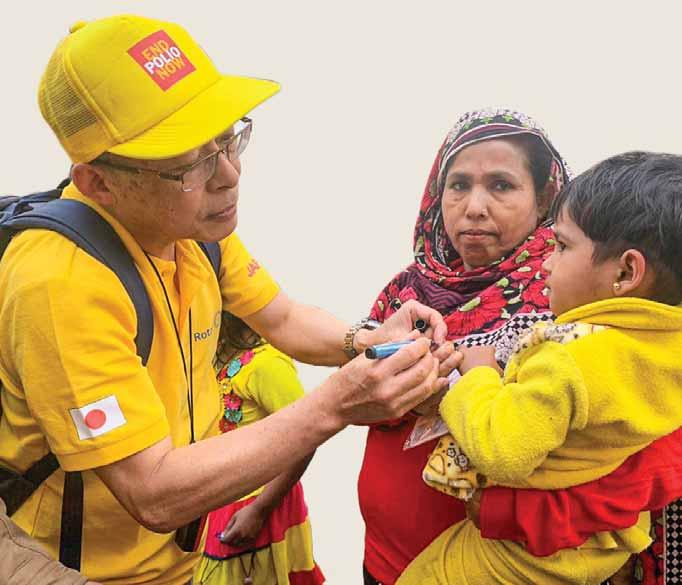


cating with governen g a gi n g re ligi ous l ea d ers, d onat i ng, d raisers, supportin g , t thousands r s , ” etc , it said that a ve v ities P akistan.”
awareness, advocating with government officials, engaging religious and community leaders, donating, and holding fundraisers, supporting, through our grant funding, thousands of health workers,” etc, it said that till now “we have supported polio eradication activities worth nearly $364 million in Pakistan.”
Memon put on record the interest, support and help extended by PRIP Kalyan Banerjee, who also called to congratulate him, and “who was always in the background, helping, supporting, guiding and in his year as RI president, when India marked a year with no polio case, he said it should be Pakistan who should achieve this next.” He also acknowledged the hard work and dedication of PDG Kassim Dada, who was Pakistan’s first PolioPlus chair (1980–88) and PDG Abdul Haiy Khan
n record the interest, p exten d e d b y e, who also called h im, and “who was a c k groun d , h e l p i ng, ing n India marked a year se, he said it should o so nd d e di cat i on Dada , who Polio8 0–8 8) an d H ai y Khan
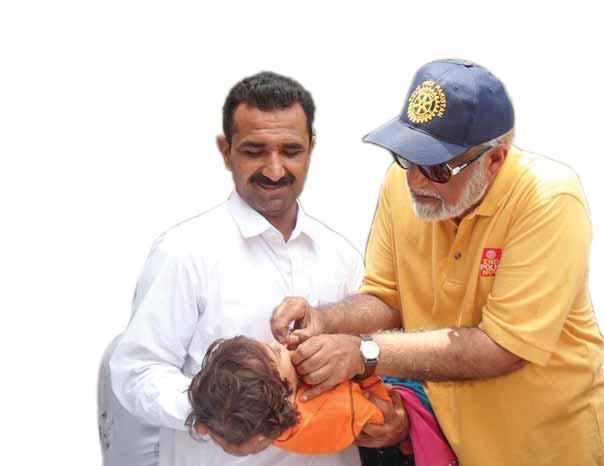

(1988— 2009), before Memon took over as the national chair.
But Pakistan’s Rotary leaders are wary of celebrating yet; “we are not even accepting the congratulations that have poured in from across the world… from Rotarians, Rotaractors, our partners and others,” says Trustee Memon. “Even while marking this momentous day as one year without any cases of polio, we know that we have to be very vigilant and this is not the end but the beginning. We can’t afford to be complacent, and will have to continue to work with our partners and the government to ensure there is no relapse, as happened in Nigeria after 21 months. So no celebrations yet as this virus can’t be trusted and can come up anytime anywhere… we have to be very alert.”
But despite this sense of caution, there is more cheerful news on polio
from the region. Last year Afghanistan reported 4 cases of polio and with Pakistan and Afghanistan sharing a common border, won’t this remain their biggest challenge, I ask Pakistan’s core PolioPlus leadership team over a zoom call. So have they had any kind of a dialogue with the Taliban who has
Prime Minister Benazir Bhutto gave the first dose of polio during that campaign to her own daughter Asifa in 1994, was the time this programme got national prominence.
Aziz Memon Pakistan’s PolioPlus chair
historically been opposed to immunising children against polio?
Responds its Punjab Polio zonal coordinator PDG Muhammad Saeed Shamsi, “Actually, a major change we see these days is that the new government of Afghanistan (the Taliban) is allowing the polio workers to go from door-to-door for giving polio drops.”
How this is a big change for the positive is explained by Memon who says, “And this has been going on for four months now. Earlier, in that region, there used to be a designated Hujra, or a gathering place, where the polio vaccinators could come and the families would bring their children below the age of 5 to get vaccinated. But this has now been changed by the Taliban to a door-to-door vaccination, something that Rotary has always asked for, but was neither permitted nor possible earlier.”
Adds Shamsi, “As you rightly pointed out we have to be very alert because we share a border with
Afghanistan. But I am very positive about the endgame in polio, because this change will really help us and make a difference.” Compared to doing the immunisation in a Hujra, giving the drops at the children’s homes left little scope for missing out children. “So hopefully we will be able to do much better than what we have been able to do in Afghanistan till now.”
Asked to walk down memory lane on when exactly the polio immunisation drive in Pakistan really took off and the extreme moments of frustration the core polio team faced, Memon says: “There were both moments of hope and frustration. At times we felt so close to eradicating polio. For eg, in 2018 we got only single digit cases of polio and felt that we were reaching the end and then suddenly a conspiracy theory was raised by a religious party in Peshawar.”
interviewing Pakistan’s PolioPlus chair and Trustee Aziz Memon on Pakistan marking the one-year milestone without any wild poliovirus case, I ask him on whether the false propaganda that the polio drops caused impotency, resulted in more girls than boys getting vaccinated. He responds: “It’s a very interesting question that you have raised! About four years ago, when the polio numbers from Peshawar and other regions in KP came up, we found most of those were boys. We were wondering what had gone wrong with the immunisation drive and then we discovered that when the polio teams came to give the drops, the mothers would take only their daughters to get the drops and hide their sons, thinking they will become impotent.”
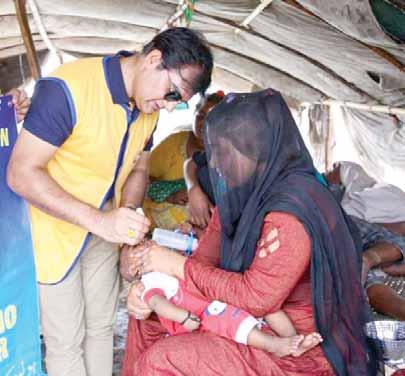
The sad result was some of these boys got polio and became crippled. But when those who became fathers after getting the drops, it was enough evidence to tell the community that this propaganda was incorrect.
Adds Punjab coordinator Shamsi, “Before going on every campaign we do a total mapping of how many children are to be vaccinated in a house. So when we found more boys than girls getting infected with the virus, we could assume that the boys were getting hidden by the parents. In many cases, we knew that a house had 2, or 3 or 4 children, and wanted to ensure all of them got vaccinated. But there were times we were not able to convince the parents.”
The rumour was that after polio drops 50 children had died; “the truth was that nobody had died. So we were fighting not just insurgency but also religious misbeliefs… spreading rumours in the name of religion. India too faced a similar situation in Bihar and UP.”
Going back in time to the precise moment when the polio immunisation drive by Rotarians in Pakistan got traction, Memon, who took over as national PolioPlus chair in 2009, put the defining moment in their polio eradication drive as the day the then Pakistan Prime Minister Benazir Bhutto gave the first dose of polio during that campaign to her own daughter Asifa in 1994. “That is the time this programme got national prominence.” On numbers, he said that at one time the number of polio cases in Pakistan were much lower than in

India. But then the Taliban insurgency began in Pakistan and with the refugees moving in from Afghanistan to Pakistan, and the Taliban becoming very active in Pakistan, the number shot up to 380.
Memon added that after Osama bin Laden was killed in 2011, the Taliban were occupying north and south Waziristan in the Khyber Pakhtunkhwa (KP) province, of which Abdul Rauf Rohaila is the zonal coordinator, and put a ban on polio vaccination. “I went there and held a discussion with them to allow polio vaccination
but their only demand was that stop those drone strikes. That was the worst time Pakistan faced in its polio eradication drive.”
But things turned for the better as the Army increased its presence in the NW region, especially after the Dec 2014 attack on an Army Public School in Peshawar by six gunmen affiliated with the Tehrik-i-Taliban Pakistan (TTP), in which 132 children died. The Pakistan Army launched an offensive on the TTP and allowed polio vaccinators access to the region, which saw a decline in the number of polio cases.
Trustee Aziz Memon explains that even though Pakistan has gone without reporting a single wild poliovirus case for a whole year, it will not get any certification from RI right now, because this works region wise in Rotary. “For eg, Sri Lanka became polio-free 18 years and Bangladesh 12 years before India but both the countries had to wait for India to
become polio-free for the region to get the certification. We come under the EMRO or the Eastern Mediterranean Region, and need to wait for Afghanistan to register zero cases to be certified poliofree by EMRO.”
Till then, he adds, “we will have to continue our struggle in the coming days and months to ensure we reach the certification of a polio-free region.”
A major change we see these days is that the new government of Afghanistan (the Taliban) is allowing the polio workers to go from doorto-door for giving polio drops.
Rohaila adds that the KP province has always been the most problematic; law and order is a major issue there, killings take place frequently, and this is a big challenge for them. Rotarians had to, and continue to, deal with the insurgency and security issues, and even three days ago, a policeman guarding the polio workers team was killed in Karak district in KP. Most of the polio-related killings have taken place in the KP province.
Asked to relate any horrific incidents that affected their visits to KP, Memon responds: “About 200 polio workers and security men have been killed in our polio eradication drive across the country. While going to Swat, Bannu and other such places, we do not allow our guests to come there, particularly foreign guests who have come for our NIDs, but if we ourselves don’t go there, who else will go?
So Rotarians have taken huge risks and always gone there and will continue to go to so many unsafe places in the KP province.”
Recalling one incident in 2007–08, Rohaila says that during the Taliban era, “we went to North Waziristan despite the Army not allowing it and
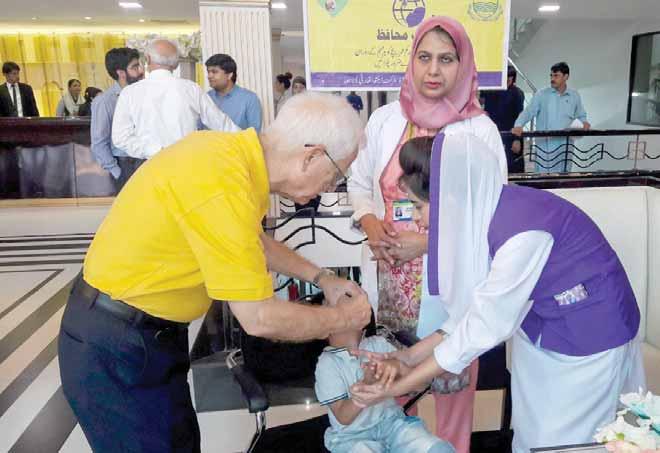
the local administration extremely reluctant to allow us. But still when we went there … Aziz Memon accompanied us, despite being instructed not to do so… and spoke in their local language, the people said nobody has come here till now and explained all this to us, and we were allowed to carry out immunisation.”
Gradually, as trust and confidence in the Rotarians were established,
requests started coming in for health camps — once the KP chief minister himself requested the Rotarians to organise a health camp some eight years ago. The Taliban were there but they allowed the holding of the camp.
When KR Ravindran was RI president, a PolioPlus Memorial Scholarship was formed in the name of the slain polio workers. It sponsored six deserving students for a two year
About 200 polio workers/security men have been killed across the country; while going to Swat, Bannu etc in KP province, we do not allow foreign guests to accompany us for the NIDs. But if we ourselves don’t go there, who else will?
TRF Trustee Aziz Memon
Masters in Public Health (MPH) programme.
Sindh zonal polio coordinator chair PP Masood Bhali adds that “both Pakistan’s defence forces and national and provincial governments have always helped and supported Rotary’s polio immunisation camps and campaigns.”
Coming to the misinformation campaign done by the Taliban and some religious leaders about the polio vaccine causing impotence, and how the PolioPlus core team combated this problem, Memon says they have set up an ulema committee which conducts regular workshops all over Pakistan to give the right information. “The Pakistan government also helped us by getting ulemas from Mecca and Medina to address meetings and workshops making it clear there are no religious or medical concerns in getting these drops which actually protect your

children from a crippling disease like polio. The children who take these drops can indeed become fathers and gradually the religious misconception subsided.”
Pakistan’s Rotarians have had to grapple with misinformation of various kinds. As Trustee Memon points out, after Osama bin Laden was killed, both in North and South Waziristan a ban was put on OPV (Oral Polio Vaccine).
“One of the main reasons was the charge that when the vaccinators come, they do the mapping and pass on the information to the CIA, about where the Taliban or other insurgents are hiding, so they can carry out drone attacks. Hence they were not allowing our vaccinators. So we said we will all come without cell phones, not take pictures, etc. So the drone attacks also lengthened our fight against polio, because after bin Laden was killed the misinformation spread was that information on his location was given by a polio worker.”
Balochistan coordinator Salim Raza says that only one case was reported in
the last year in Killa Abdullah, the red zone of polio. Awareness campaign involving Killi elders, religious leaders, and others helped in reducing the refusal rate. “Being close to Afghan border, it is a challenge to control the virus. So all incoming and outgoing people are being vaccinated and monitored,” he says.
Frontline workers of Permanent Transit Points (PTPs) erected on roadside at selected points, are very proactive and helpful in checking and administering polio drops. “We have to be extra careful to sustain the tempo of awareness campaigns, and ensure access to polio drops for all children.”
After trust was established, the community approached Rotarians saying they had no water, roads etc. “Building roads is a huge job which only the government can do, but wherever we could, we have helped the local communities in several ways. We’ve set up water filtration plants, permanent immunisation centres (PIC)
and conducted several health camps to emphasise on the ‘Plus’ in our PolioPlus programme and give the message that we come not only to give two drops to their children but also to take care of the health of the whole family. This has increased the acceptance and the confidence in us.”
The Rotarians also conduct polio corrective surgery, with many clubs such as RCs Karachi and Lahore having permanent centres to rehabilitate those afflicted by polio. “Much more than surgery, we give crutches or fit the Jaipur foot. Donors come forward to support surgery and rehabilitation efforts,” says Memon. Shamsi adds that in Lahore corrective surgery is being done by Rotary from 1964.
On what next Memon underlines the need for vigilance, as “our biggest problem is a high-risk mobile population”. The PTPs set up by the polio immunisation programme will ensure precaution is taken when migrants cross over from one province to another. In Sindh alone there are 29 such PTPs and 42 across the country. Shamsi explains that as the Punjab province is economically better than the others, there is a lot of crossing over of people who come here for work. “We ensure that these are manned for 24 hours and if the workers bring children, polio drops are given to them.”
Memon adds that at the PakAfghan borders, Rotary has put up All-Age Vaccination (AAV) immunisation posts and even adults are given drops as they can be carriers too. “Just as when you go for Haj, the Saudi government ensures that all adults have taken polio drops.”
Pics: Pakistan’s PolioPlus archives Designed by N Krishnamurthy
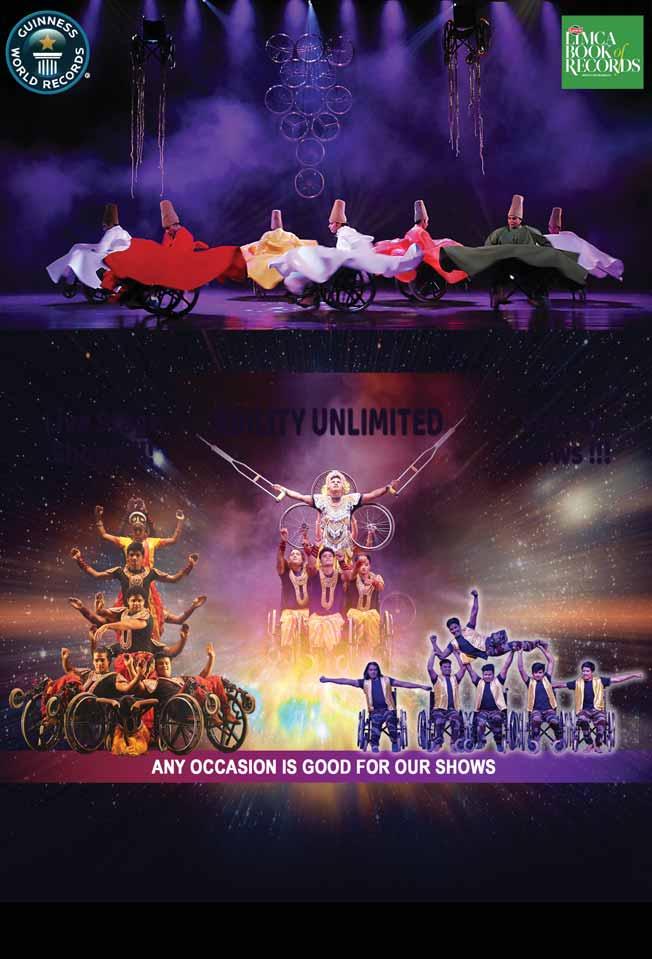






President-elect Jennifer Jones’ office at Rotary International World Headquarters in Evanston, Illinois, feels different from those of her predecessors, but that’s in no way a result of the fact that on July 1 she will become Rotary’s first female president. On the wall hangs a recent gift from a friend — a black scratch-off map on which she can record every Rotary destination she visits during the next two years. It’s September, two months since she took office as president-elect, and on the map, only Chicago has been revealed — many planned events were canceled or postponed due to a rise in Covid-19 cases. Today, she is the only person on the 18th floor of One Rotary Center. There are no phones ringing, no fingers tap-tap-tapping on keyboards in the cubicles outside her door. One could do cartwheels through the Rotary boardroom and nobody would notice.
Jennifer elbow bumps her visitors, Rotary magazine senior staff writer Diana Schoberg and senior editor Geoffrey Johnson. Then, spaced apart at a table in her office, they discuss her vision for the year ahead. “If you start to think about how exponentially Rotary can touch the world, we’re more than a club,” she says. “We’re a movement.”
Jennifer is president and CEO of Media Street Productions Inc in Windsor, Ontario, where she is a member of the Rotary Club of Windsor-Roseland. (Her husband, Nick Krayacich, is past president of the Rotary Club of La Salle Centennial and was recently selected as governor-nominee-designate of District 6400.) Her company’s specialties include radio and television production, corporate and nonprofit videos, and live show productions.
Using her media background to elevate Rotary’s global profile is one of the primary goals of her presidency, and she is planning what she calls the “Imagine Impact Tour” to showcase to
President-elect Jennifer Jones is poised to lead Rotary into a vibrant, diverse future.
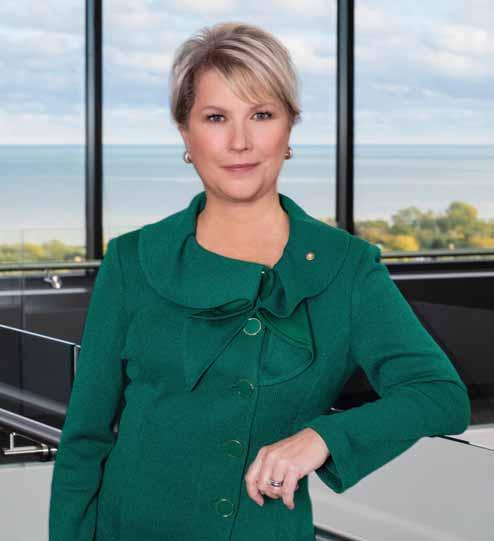
the world several large-scale, sustainable projects in each of Rotary’s areas of focus. “I see this as a way of increasing our membership,” she says. “When we tell our stories, like-minded people will want to join with us.”
A Rotary member since 1996, Jennifer played a lead role in the organisation’s rebranding effort by serving as chair of the Strengthening Rotary Advisory Group. She is co-chair of the
End Polio Now Countdown to History Campaign Committee which aims to raise $150 million for polio eradication efforts. She also led the successful #RotaryResponds virtual telethon in 2020, which raised critical funds for pandemic relief and attracted more than 65,000 views.
Between more serious topics such as elevating Rotary’s image and its efforts toward diversity, equity, and
inclusion, the conversation jumps around to the retro appeal of the 1980s television show The Golden Girls (its social commentary is relevant even today, Jennifer surmises) and dance parties (“Whenever a good song comes on, it’s hard to not get a little groove on,” she says). Towards the end of the conversation, her dad chimes in with a ding on her phone and the one-word message, “passed” — he’s still working at almost 80 years old and wanted to let her know he’d succeeded at an annual exam for his job.
“He is the sweetest thing,” she says with a smile. A few days earlier, his text to her had included a heart emoji and the query “How’s fixing the world coming along?” With the family of Rotary behind her, Jennifer is well on her way.
You’re going to be Rotary’s first female president. What does that mean for Rotary?
When I was selected, although the process was virtual, everybody went around the “room” to reflect on something that was said during the interview. One of the points that was repeatedly emphasised was that I was selected for my qualifications, not because of my gender. I didn’t enter the interview with gender being at the forefront of my thinking. However, I do think that for our organisation, it was an incredibly significant moment. Diversity, equity and inclusion is so important not only for Rotary but for our world. Maybe my nomination is happening at the right time.
When I gave my acceptance speech at the 2021 virtual convention, I mentioned my 10-year-old niece during the opening. She had given me a drawing of herself that included the words, “Different is always better. Different is me.” I loved it and was so proud of her for proclaiming this statement, so much so, that I ended the speech using her exact words. Being different is nothing to apologise for. One of our core values
is diversity, and this is another way that diversity is represented. It’s just that it took 117 years for that to happen.
What does diversity mean for our organisation?
There is diversity in our Rotary world, but is there diversity in our own most immediate sphere, our own clubs? When we have diversity of thought, diversity of age, diversity of culture, diversity of gender, diversity of vocation, we bring that to the table. That is our secret sauce. That’s what allows us to solve things in ways that others can’t.
Have you met a 25-yearold who is old? We all have. Have you met an 86-year-old who is young? Of course. So I talk about young thinkers.
We’re looking at it through that kaleidoscope of experience that we bring to the table.
There are going to be clubs that say, “No, we’re good. We’ve got diversity figured out.” And maybe they do and maybe they don’t. But I think we are uniquely poised as an organisation at this time in history to be the honest brokers of these kinds of conversations. Because we’re nonpolitical and nonreligious, we have the ability to host this type of dialogue and do it in a safe space where we respect each other.
How will you redefine the role of Rotary president?
I don’t know that I’m approaching the presidency from a perspective of change. I’m looking at it from the perspective of how we exist as a relevant organisation in today’s culture and
climate. How do we do things that are proactive and positive for our future?
Maybe it’s a bit of a shift in what we’ve been striving for over the past several years, in terms of reaching specific demographics. Perhaps we need to walk it more authentically. If we’re going to ask more women to join our organisation and we’ve seen negligible results, perhaps this is an opportunity to inspire others to look forward and say, “If she can do it, so can I.” If we’re looking for younger members and younger thinkers to be in our organisation, then we need to exhibit that behaviour. We need to showcase why it’s important to them — to make sure we’re giving people meaningful, intentional things to engage within our organisation.
The biggest thing that I’m hoping I bring to the table is not gender but communication — how we communicate these things to our frontline members and others who are part of our family, to understand that being different right now is a good thing and that it doesn’t change who we are. Our DNA remains true. Our core values stay true. Those are things that don’t go out of style. But can we look at things through a little bit of a different lens right now?
You’re saying young thinkers as well as young members. What’s the distinction?
Have you met a 25-year-old who is old? We all have. Have you met an 86-yearold who is young? Of course. So I talk about young thinkers. It’s something that resonates regardless of where I am in the world.
Embracing the fact that we are people of action speaks to our joie de vivre We step out. We do things. That is what I think of in terms of young thinkers. We’re the people who make things happen in our world and our community.
We have such a brilliant opportunity to capture what I like to call cross-mentorship.
Sometimes a great idea comes through the lens of experience, and sometimes it comes from someone who hasn’t already been told that they can’t do something or that it needs to be done this certain way. When we look towards younger participants in our organisation, they give me hope that we can look at things through fresh eyes, that we can constantly be in a state of evolution.
This is going to be a very wide generalisation: If you have a great new idea, and you give it to a Rotaract club, within days they figure out what it is that they’re going to do. They’ve launched some sort of social media presence. They’ve called out and connected with partners. They’ve done all kinds of things. They take action really fast. Similarly, you can give it to a Rotary club, and what do we do? We form a committee and then we have meetings, lots of meetings.
That’s not to be dismissive of that more deliberate path; I say that very much in jest. But the bureaucracy sometimes can bring us to a slow stop and be frustrating for people.
There is an opportunity for us when we look towards the younger demographic. They just do things differently. And I think that’s something we truly can learn from them.
You’re a natural storyteller. What’s the first sentence of the opening chapter of your presidency?
It’s one word: imagine.
That’s your theme, right?
Imagine Rotary.
How did you come up with that?
Imagine to me is about dreams and the obligation to run after those dreams. I want people to think about the things that they want to achieve, and then use Rotary as the vehicle to get there. We have such a huge array of opportunities
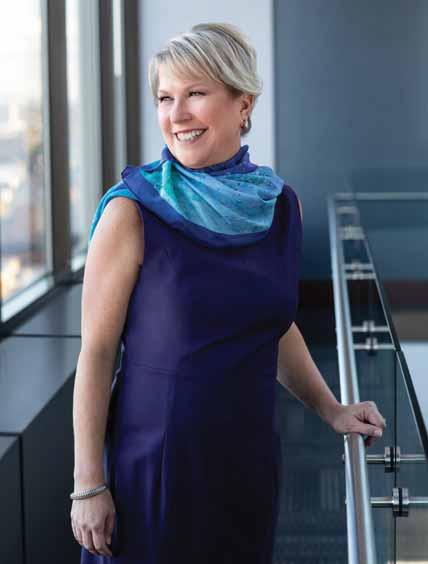
in front of us, but we need to channel our energies so that we make sustainable, impactful decisions about what we do. The most powerful thing for a member is to be able to say, “I have an idea.” And then to share that with others and to amplify it and figure out where to go with it. Imagine is an empowering word, giving people permission to say that they want to do something to make their world better, and they can do it because they’re part of this family.
What is contemporary leadership, and how does your style of leadership fit in?
The past two years have given us this deep opportunity to take a look at
what’s important to us and what things we want to get rid of, that carry too much baggage in our head and on our shoulders. Now we can look forward to how to do things a little bit differently and, probably most important, more authentically. How do we be true and honest to ourselves about what we want to spend our time doing, whom we want to spend our time with, and how we can work toward supporting each other better, not just as friends and neighbours but as humanity?
From a contemporary leadership perspective, we need to take the best from the worst. We’ve watched world leaders broadcasting from their kitchens and from their basements.
We have learned how to be different and more appreciative of other people’s experiences. As Rotary, that’s what we’ve been good at all along. This is our time to shine.
What strengths and weaknesses do you bring to the presidency?
I’m proud of being a connector. I like to connect people, and I like to connect people to stories. I’d like to see how that can be harnessed. I think my strength is also in communication and looking at how we can do things just a little bit differently. The most important thing that we can do is make sure that every member of our organisation understands what it is to be part of it. There are many different ways to communicate that, and it’s not just about sending an email. It’s about creating a reason for people to want to hear from the organisation.
One of the things I want to do is go live directly following a board meeting. I want to tell people what their
In association with the Ratna Nidhi Charitable Trust, Mumbai, Rotary clubs of Mumbai, RID 3141, and RC Dharamshala, RID 3070, organised an artificial limb fitment camp in Dharamshala, Himachal Pradesh. Around 165 physically-challenged people were fitted with Jaipur foot and wheelchairs were given to 10 people. DG Rajendra Agrawal (RID 3141) and DG Dr Upinder Singh Ghai
organisation is doing — what just literally happened. Breaking news from the 18th floor in Evanston, and here is what it means to your club experience. Can we tell that story? I want to use some of the newer tools; when I’m travelling in the field, I will have my little GoPro camera. I want to field-produce my own presidency. I want to showcase what I just saw and what this person just said to me.
A weakness? Balance. Trying to take care of myself — trying to eat right, exercise, make time for friends and family. I’m not always good at it. I think this harks back to the conversation we’re having about the pandemic. We’ve all had this opportunity to push the pause button. Sometimes we go a thousand per cent toward something that we’re working on, when that’s maybe not the right approach. We can be stronger when we’re better to ourselves. I think we’ve really learned this; at least I have.
One of the things that I have taken pride in my entire life is not dropping
balls. I’ve arrived at a place where there is a lot going on, and at the same time I’ve given myself permission to drop some balls.
There are so many different ways that people now communicate, whether through email, text, WhatsApp, Facebook, LinkedIn, or Twitter. I’ve got two phones going. It’s crazy. So I have given myself permission to walk away and to not be tethered to my phone. I’m aware of it, I am respectful of it, but I need to be a little bit more present. I could literally be communicating 24 hours a day. And that doesn’t serve anyone.
You are well known for being a hugger. So what’s the new hug?
That’s a tough one. Elbow bumps are definitely going to be a pattern going forward, maybe a fist bump here or there. Hugs are probably on hold for a little while.
Pictures by Monika Lozinska ©Rotary

(RID 3070) participated in the camp assisting a team of 170 Rotarians from various Rotary clubs of RID 3141 and the host club members.
The Rotarians later distributed 5,000 notebooks among 50 Happy Schools and provided warm clothes to 800 underprivileged people in the city.
Rasheeda Bhagat
In January 2021, when PDG Rajiv Pradhan from RI District 3132, along with Rotarians of the five Rotary clubs in Jalna, and one in Ambad, Maharashtra, felicitated Maharashtra health minister Rajesh Tope, as a Covid warrior for the exemplary Covid management the health department of the State had done under his leadership, the minister was once again briefed by the Rotarians about the multiple medical missions that Rotary has done in Africa and India. “Not that he was not aware of our work; as he comes from my city, Jalna, and I had told him several times in the past about Rotary’s medical missions, in 10 of which I have participated, in Africa and India, the
minister said why don’t you think of doing one in Jalna,” says Dr Madhav Ambekar, an eye surgeon from RC Jalna.
The Jalna Rotarians, and PDG Dr Pradhan, another veteran of Rotary’s medical missions, embraced this idea and the latter made a trip to Jalna subsequently to discuss with the Jalna Rotarians the nitty-gritty of organising such a camp. In the initial

planning, “Rotarian doctors from Solapur, Nanded, Nagar, Satara and Panvel agreed to go to Jalna for 8-9 days. But just then, the second wave of Covid started, so there were many concerns and logistics problems. But our Rotarian surgeons from Jalna, as well as government doctors, rose to the occasion and the visiting doctors were requested not to venture to Jalna,” says Dr Pradhan.
Rtn Dr Rameshwar performing a laproscopic gall bladder procedure at the medical camp in Jalna.


Dr Rameshwar and Rtn Dr Somani, anasthesiologist, at the operation theatre.


With two Rotarian doctors — Dr Ambekar and Dr Suchitra Gadiya (an anaesthetist) from RC Jalna Central, taking all the administrative responsibilities, the camp which had to be initially delayed was finally held from Jan 4–10 after getting the go-ahead signal from RID 3132 DG Omprakash Motipawale, as the pandemic was still on.
The Rotarians never lost sight of the fact that the pandemic was still on, and because of awareness spread through the government machinery, specially the ASHA workers, many people were aware of the camp and a huge crowd was expected. “So we did face a dilemma, but then requested those not in immediate need of surgical intervention to please stay away, and a secondary screening was done.” Here the doctors counselled and convinced patients who did not need immediate surgery that as the
Covid threat was still on, they should not take a risk by coming to a hospital for something that could wait.
On the main challenges faced in organising a mega medical camp during a pandemic, Dr Ambekar says, “This was in convincing the government staff to do a doorto-door survey, when the health machinery was so tired, because all of their efforts had been directed only at Covid management and treatment.” With the government doctors requesting the Rotarians to convince and motivate the staff to contribute wholeheartedly for this camp, “we talked to them and convinced them to work enthusiastically for this camp.”
He says the real essence of this project was that “from the very beginning I made everybody aware
From the very beginning
I made everybody aware that let’s consider this as not the project of a few clubs but the entire Rotary family of Jalna and all its clubs… we called ourselves ‘Rotary parivar’ hosting the medical camp.
Dr Madhav Ambekar member, RC Jalna
that let’s consider this as not the project of a few clubs but the entire Rotary family of Jalna and all its clubs… we called ourselves ‘Rotary parivar’ hosting the medical camp. The money collected needed to be put somewhere so we put it in RC Jalna Trust.”
What the Rotarians were planning was really big and they put
forth a budget estimate of `25 lakh, and were confident of collecting it as several industrial houses from Jalna, such as Jalna Steel Manufacturing Association, Kalash Seeds, Vikram Tea Processor and a number of Rotarians gave financial support. “A shot in our arm was two philanthropists who gave the major funding — Dhanshyam Goel and Satish Agarwal — telling us not to worry about the funds as their business houses would give us whatever was required,” said Dr Ambekar. The Annamrut Foundation, a community kitchen, provided food at subsidised cost on all days to all the patients and hospital staff.
The Rotarians led by Dr Ambekar, Dr Sumitra and Dr Christopher Mosses had a series of meetings with the district health officer, CEO of the zilla parishad, the district collector and the civil surgeon Dr Archana Bhonsle. The health minister assigned his

OSD Dr Gaurishankar Chavan as a liaison person. The team had to deal with several issues, including paucity of equipment, surgical disposables, medical supplies, etc. The surgeries were planned in the Government Civil Hospital, Government Women’s Hospital and the Ambad sub-district hospital.
Patients were selected through an outreach programme, “as conducting an OPD with a large number of patients visiting, was not possible due to Covid.” All PHC staff of three talukas and ASHA workers went from house to house to identify patients awaiting surgical treatment for branches such as general surgery, ENT, gynaecology, orthopaedics dental and ophthalmology. Banners, posters and brochures were distributed by Rotarians in 20-plus PHCs.
Says Dr Sumitra, “The government machinery was amazingly co-operative and they realised that as private doctors are helping out, all possible help and assistance should be rendered and medical equipment supplies and medicines were arranged

by the government. The crowd was well managed, the patients were properly guided so Covid protocol could be followed, and everyone were screened for Covid.”
An amount exceeding `4 lakh was left over and when we returned it to the sponsors they were flabbergasted. They said we fund so many charitable projects, but this is the first time we are getting some of the funds back.
PDG Rajiv Pradhan
Most of the operating theatres in both the government hospitals were used by the doctors and “surgeons literally performed dawnto-dusk operations to take the total number of surgeries to 673 in all. Actually, the government surgeons continued to operate for a few days afterwards too as patients had been identified,” says Dr Ambekar.
Dr Anil Thakre, who led the gynaec team, said that almost 43 cases of hysterectomy which had been pending for some time due to the Covid pandemic were performed by the team of surgeons.
Dr Sumitra adds that “the Rotarians of Jalna are now confident that they can now scale up such projects and plan similar projects elsewhere in District 3132 and beyond. PDG Pradhan adds, “I could not personally be present in Jalna due to Covid, but I was constantly in touch with them.
Dr Ambekar, Dr Sumitra and all the club presidents did such wonderful work, that my absence wasn’t felt! The seeds of the medical projects sown by PRIP Rajendra Saboo, have now blossomed into a new and vibrant generation of dedicated Rotarians who can carry on or even surpass the work I have done in the last 23 years.”
Leaving the best part of the story for the end, though the Rotarians had initially planned for a budget of `25 lakh, they slashed it to `10 lakh as the size of the camp had to be curtailed due to the pandemic. “So we asked for `10 lakh from our sponsors, but the government machinery swung into action and the initial material which was not available was somehow got by the government, so we could control the project cost. An amount exceeding `4 lakh was left over and when we returned it to the sponsors. They were flabbergasted and they said we fund so many charitable projects, but this is the first time we are getting some of the funds back. Whatever you need in the future, please come to us!” said PDG Pradhan
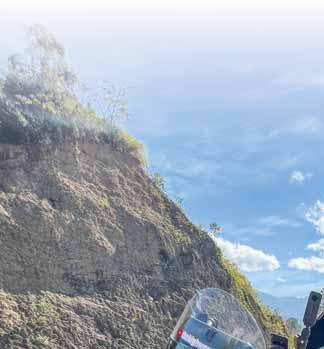
Rasheeda Bhagat


Riding along the smooth roads, with forest-clad peripheral mountains keeping me company, and the densely populated Brahmaputra valley with its lush green tea gardens and golden rice fields, the moderately populated hill regions and plateaus, and the sparsely inhabited Himalayas in the backdrop…. all of this came together to form a unique mosaic of natural and cultural landscapes to make my trip very special.”

Vishal Gupta, an avid biker and charter president of RC Siliguri Central, RID 3240, and before that an Interactor and Rotaractor, turns poetic while describing his recent exciting expedition on his beloved Harley Davidson Softail Heritage 2021, while participating in the Hornbill Festival.
“Our 7-member group did a 6-day ride from Siliguri to Guwahati, Guwahati to Dimapur and then onwards to Kohima, Nagaland. I was the only Rotarian in the group and strove to promote Rotary’s public image by carrying the Rotary flag, and wearing the Rotary logo on my riding jacket,” he says proudly.

To encourage intertribal interaction and promote cultural heritage of Nagaland, the Nagaland government organises the Hornbill Festival every year; the first was held in 2000.
The festival is named after the Indian Hornbill,
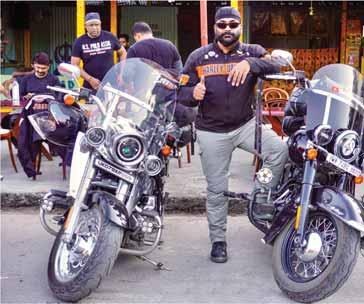
Rtn Vishal Gupta with his Harley Davidson. the large and colourful forest bird which is displayed in the folklore of most of the state’s tribes.
Going into raptures about his adventure, this avid rider who had been riding from 1997, is all praise for the people of Nagaland; “they were so kind, friendly and hospitable. For someone who loves to explore mountains, highways, rivers, good food, hospitality, the North East comes with a full package.”
Explaining his passion for riding, Gupta says for him, riding is not just about “getting up, sitting on a bike and reaching a destination. It needs planning and meticulous execution.” An automobile dealer himself, his planning began with
getting his latest Harley bike from the US. “I chose a Harley because it is a heavy and sturdy vehicle and safe.” On the road it cost him around `32 lakh. They stayed in comfortable 3-star hotels and the money every participant in the festival spent, including the cost of petrol, hotels, food, etc was around `50,000 to 60,000.
His group’s ride began from Siliguri, and the first destination was Guwahati, and the 550-km stretch with “perfect roads, highway and disciplined riders and drivers, was delightful. On the way you will experience small towns like Malbazar, Tihu, Bangaoigon, and get a good choice of both veg and non-veg food, and the warmth of local people will mesmerise you.”
The next day the group started from Guwahati at 7am and reached Kohima

around 8pm after a brief halt at Dimapur. Though most of the journey was on smooth roads, the team of riders did hit bad patches with rough and broken roads, particularly before they reached Kohima. In one particular patch, where the road was being made and had lots of stones and rubble and water to boot, his mobike skidded and he had a fall. “But I was at a very low speed and had a very light fall.”
Anovice on bikes and riders, I ask him why couldn’t he control the bike as he was going at a very low speed, and he says, “The temperature was 3–4 degrees, the road was wet and my bike turned completely, which means 180 degrees. My Harley weighs about 485
kg, and when these bikes fall if you try to stop or break the fall, you will end up either breaking a bone or get hurt very badly.”
The riders found the food amazing; “I am a vegetarian and had no problem at all as all kinds of vegetarian food was available. But it was the people who made our trip. They were so protective and kept warning us about not going out on the roads as there is insurgency in that region.”
He recalls an incident; when the 20-odd riders rode into Kohima, “by mistake I took a wrong turn and ended up on the wrong side of the road. The policeman not only showed me the right route, but also stopped the traffic to allow me to get out from the wrong side of the road. Such gestures leave such a happy impression in your heart! Overall, it was a fantastic experience.”
Here is a valuable tip from this veteran visitor. “If you wish to explore Assam I strongly suggest you ride or drive from Siliguri and explore the beauty of the North East, its rich heritage and embrace the confluence of religions, traditions and customs. Don’t forget to buy the local Assam tea and visit the villages made of bamboo, it is one experience you’ll always remember,” adds Gupta.
You can follow Gupta on his youtube channel https://youtube.com/ thehighwayrider


Kiran Zehra

biochemistry machines donated
amil Nadu heaalth minnisster Ma Subramannian inaauggurated an ultrasound colour doppler (UCD) and fuully-auttommated machinees donaateed by RC Madras Centraal (RCMMCC), RID 3232, to the Omaanduraar Government Hospitall, Chennnaai
“We have a long queuue of patiients waiting for diagnosis,” says Dr Sowmya Shanmugamm, from m thhe Radiology departmennt, as doocttors started using the new w equipmmeent immediately.

accurate. It replaces expensive and invasive modalities like angiography,” she says.
Clad in a blue patient’s gown, carrying her IV push chemo drip in her hands, 23-year-old Shobana, a leukemia patient, peeps into the room where the new UCD is placed to “get a glimpse of the machine
that can help in my treatment,” she smiles. Nurse Ramuthai tells me later, “Shobana’s cancer has no cure and she has only a few years left. With the help of the new machine, we can understand the reason n foor her pain and instantly administer an injecti t on o to o relieve it Because e the e machine is m b obilee, our ur work k in i shifting patients like her froom m onne e place to another for tests s willl l a also o b be reduced ” .”

waiting at the palliative care unit with nurse Ramuthai.
blood flow in the region.
Rotating the UCD D probe e over the shoulder and d chest t of a 50-year-old patieent, shhe e pointed at a coloured spot on the ultrasound screeen and confirmed restriccted blood flow in the regiion


“Not only does this m machinne detect and determine the direction and velocity y of the blood flow in various organs, but it is safe, costeffective, portable, and highly
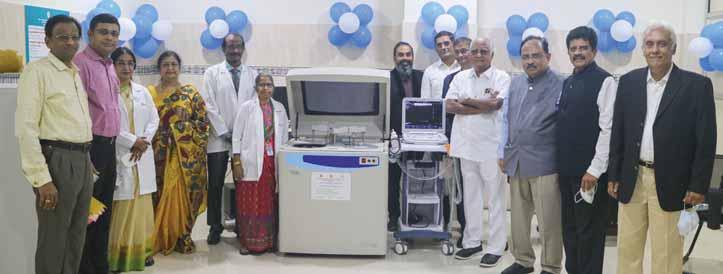
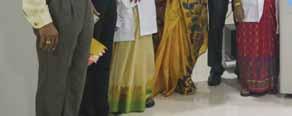
From left: Gopinath, SR Balakrishnan, Omandurar Government Hospital Dean Dr R Jayanthi, Nallammai Ramanathan, Dr Kumar, Dr Shanthi, Harishkumar, DRFC Ambalavanan M, Raghav Rao, PDG Abirami Ramanathan, Dr P Srinivasan, Vinod Saraogi and Suryanarayana Rao.
Not only does this machine detect and determine the direction and velocity of the blood flow in various organs, but it is safe, cost-effective, portable, and highly accurate. It replaces expensive and invasive modalities like angiography.

increasing medical assets come with additional requirements of reporting and maintaining quality care. But we are ready for the challenge.”
At the press conference, health minister Subramanian requested the club to “keep up the good work and help us develop the community. This gift of advanced medical equipment will benefit countless needy patients.”
requested him for this particular equipment. We approached DG J Sridhar and he supported us with the DDF.”
Pllac a ing g samplees inside th t e m machhiine for t tests, Dr R Shannthi, heaad d of the Bioc o h heemistry y department, is s especiallly y “thrilled to w worrk with t thhe Automated Biocchemmisstry y Analyser.”

S She e expllai a n ns: “O “ urs is a 400-beed govvernnment-owned s supper-sppeciiallty h hospital. We can now perfoorm mu m ltiple tests (neearrly 2000 saammplees for different d diiaggnosis) on a sinngle platform, c cuut dowwn on n timme-consuming t testing annd anaalytical processes and g get r relliablle diagnostic inforrmaatioon. Of course,
The hi-tech machines “came at a cost of `23 lakh, which was supported by global grant (GG), for which the partners were RCs Karachi (3271), Hills Kellyville (9685), Nipigon (5580), Medicine Hat (5360), Cataraqui Kingston (7040), a direct gift of $18,741 by club member PDG Abirami Ramanathan and a DDF of $3,000,” says Dr P Srinivasan past president of the club. He, along with club members SR Balakrishnan, Vinod Saraogi and AG Balaji, began work on this GG “after Ramanathan had visited the hospital earlier this year for the inauguration of some other medical equipment and the hospital dean
Saying that “we have given you what you asked for and our job here is done,” PDG Ramanathan asked the dean to “ensure that the machines are used only for the underprivileged. No poor person should be prevented from receiving quality healthcare for lack of money,” he added.
Dr Jayanthi added that most, “if not all our patients are daily wage workers, housemaids and people from an extremely poor background who cannot afford quality healthcare. We are extremely grateful to RCMC for providing this generous gift.” She added another request, a radiofrequency ablation machine; “the addition of this equipment will make our palliative care unit complete and comprehensive.” To which Ramanathan said “We will get it for you. Get ready to organise another inauguration event soon."
Pictures: Kiran Zehra
Here is an RCC whose community service is as meaningful as that of a Rotary club. RCC Bangalore Vidyaranyapura (RCCV), sponsored by RC Bangalore Vidyaranyapura, RID 3190, was formed during the early days of the Covid-19 second wave when a team of 15 service-minded people came together for an oxygen supply and installation project to meet the huge demand for oxygen. They worked

relentlessly for two months providing oxygen supplies to 80 patients, and supported ASHA workers with N-95 masks and oximeters. “We visited homes of Covid patients to fix oxygen cylinders and give masks. Most of us tested positive eventually, but touch wood, all of us survived,” says RCCV president Mohammed Sikander. The team was lauded for its Covid relief work by the WHO with an appreciation letter and an invitation to the WHO headquarters
in Geneva, Switzerland, for the World Health Day (April 7, 2022).
The RCC was formed with 15 members, including eight women, in May 2021 at the instance of Philips John, IPP of the parent club and B Srinivasa Babu, a Rotarian, who heads the WHO steering committee in Delhi. This RCC is so passionate about community service that “it poses a competition for Rotary clubs,” says Paul Mundackal, the district RCC chairman.
Members of RCC Bangalore Vidyaranyapura, along with its president Mohammed Sikander, planting a sapling.
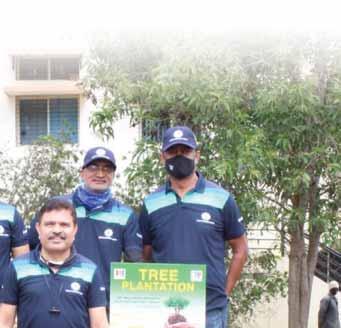
demand for oxygen worked an invitation to the WHO the district RCC chairman
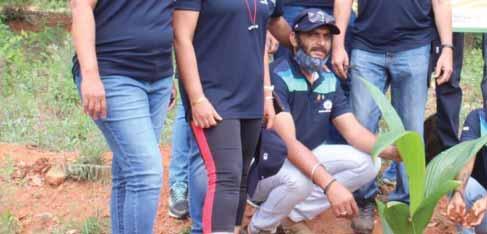


The RCC is presently focusing on welfare programmes for the Halakki tribe in a village near the Kaiga nuclear power plant on the west coast of Karnataka. “The 300,000-strong tribe continues to follow its own unique language, traditions and lifestyle. But the tribals need administrative and health-related assistance. WHO will be funding our projects here,” says Sikander.
The team has been organising health check-up camps regularly in and around Vidyaranyapura. Awareness campaigns on menstrual hygiene and associated waste disposal, and distribution of reusable sanitary napkins among underprivileged women and adolescent girls form part of the health camps. “More importantly we create awareness among people about generic medicines which are just onefifth the cost of branded ones and are equally effective. People on regular medications for BP, diabetes, etc, are able to save a lot now,” he says.


o p equ med able pa ig the D N e t leg e prom me d have 300
Through the ‘Punarbhava’ campaign the team, in association with the Dr Rajkumar Eye Bank, Narayana Nethralaya, Ramaiah Medical College and the ESI Medical College, promotes eye and body donations for medical research. “Our campaigns have helped Narayana Nethralaya with 300 eye donors.”
We create awareness among people about generic medicines which are just one-fifth the cost of branded ones and are equally effective.
Mohammed Sikander president, RCC Vidyaranyapura
The ‘Apathbandhava’ programme includes a Rotary helpline and an ambulance equipped with a defibrillator. The members have undergone paramedical training to handle health emergencies and the local doctors extend help in times of need. The RCC’s ‘Marpu’ programme provides motivational workshops for the transgender community.
Sikander was a member of RC Hyderabad East (RID 3150) for eight years until 2008 when he shifted to Bengaluru. The RCC members are neighbours in Vidyaranyapura, a residential-commercial colony in North-west Bengaluru. “When I came here, most of them did not know much about Rotary. I shared with them Rotary projects, bylaws, etc, on our WhatsApp group and got them interested in Rotary. Then we began reading about how RCC models were successful in countries like Nigeria and Japan. And Philips John gave the final push for forming the RCC,” he says.
The parent club has been good in terms of support but Babu has been a major contributor through his company’s CSR for the RCC projects. “He is a cotton manufacturer/exporter, very considerate and an amazing uniter. When we have ego issues he makes sure that nobody gets disturbed. One of our RCC members lost his job during the pandemic. Babu set up a chain of grocery stores for him in Vidyaranyapura, pays him a salary and also 10 per cent share in the profits,” smiles Sikander.
The average age of the members is around 50 (Srikanth at 70 is the oldest and Clement (18) is the youngest), and most of them are entrepreneurs. The families also get involved in welfare activities. “The spouses of our members take part in menstrual hygiene programmes, and talk to the women and girls.” The children also chip in for projects. They volunteer in the medical camps and distribute books
or stationery in schools. The members meet officially every Saturday and go online to discuss or tweak the programmes. “When all get together, we are about 30–35 people including children and spouses,” he says.
The club does not confine its projects to its own locality or any particular area. When one of the members was on a visit to Kalpakkam near Chennai, he came across a group of malnourished children of fishermen who were playing Ludo by drawing the grids on the floor and using pebbles for coins. “When he related this to us, we immediately provided them board games, sports goods, books and an almirah.” More recently the club, along with its parent club, provided basic infrastructure to a government high school in rural Bengaluru. Balaji Nanabala, the parent club president, is delighted with the RCC’s activities and “he joins us in many of our programmes,” says Sikander.
Of the 60 RCCs in the district, six are very active, says Mundackal. One of them — RCC Beglihosahalli — has even executed a global grant project with the help of its parent Rotary, RC Bangalore South.
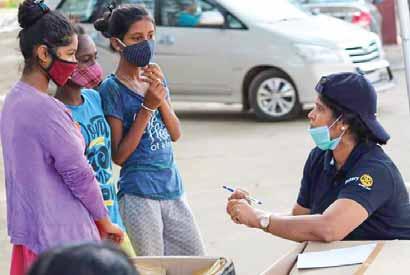
The RCC was instrumental in providing eight smart classrooms with preloaded syllabus for Classes 1 to 12, and solar panels to provide electricity to the Green Valley School in Beglihosahalli, a backward hamlet on the city’s outskirts. It was formed in 2019 when Dr Jai Prakash, the then president of the parent Rotary, during his visit to the school, was impressed by the overall performance of the students, says the RCC chairman and the school’s trustee Muniswami. The total project cost was `27 lakh of which `20 lakh
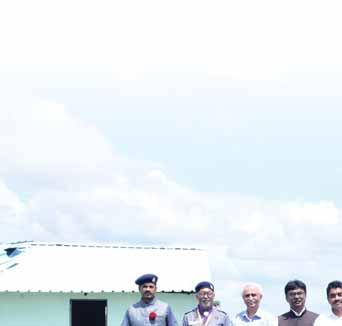
was raised through the GG and `7 lakh was contributed by the parent club. The school established by Muniswami and three of his friends in 2006 caters to 1,200 students from across 72 surrounding hamlets. Buses are in place to transport the children to and from the school.
“We have been consistently giving 100 per cent results in the Class 10 board examination,” he adds. The RCC organises RYLA and career counselling sessions for the higher class students.
L to R: Rtns V Babu, Suresh, RC Bangalore South past presidents B S Jai Prakash, H R Satish, Rtn Babu Nagendra, RCBS president Rajeshvari Suneel, Rtn Usha Dongre, H V Veeresh, club secretary M R Shivaram, Karnataka Vignana Parishad district coordinator Manjula Bhima Rao and RCC Beglihosahalli chairman B Muniswami at the Green Valley School, Kolar.
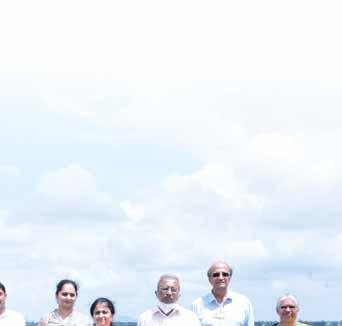




he contemporary generation would not know of India’s long struggle and victory over polio. It was on January 13, 2011, when twoyear-old Rukhsar of Howrah became the last polio victim. All nations of South Asia had become polio-free 10 years before India.
Sir Clem Renouf, the incoming Rotary International president in 1977, came across an article in the Reader’s Digest about the eradication of smallpox and wondered if another disease could be eradicated worldwide. He identified polio as the biggest threat to children. In 1979, Rotary initiated polio immunisation for six million Filipino children by OPV (oral polio vaccine), developed by Dr Albert Sabin. Big action started in 1985, when the WHO CDC (Center for Disease Control of the US) joined in and Bill and Melinda Gates Foundation became a significant partner.
Although the World Health Assembly adopted eradication of polio in 1988, nothing had happened in India till 1993–94. Thereafter, action was accelerated by Dr Harsh Vardhan, the then health minister of Delhi, as he demonstrated that all children aged five or younger would be immunised in one day. This was effective and known as NID (National Immunisation Day), which was carried out across India. The credit for this went to union health ministers Sushma Swaraj, Anbumani Ramadoss and Ghulam Nabi Azad. Still, there was huge resistance from the minority communities. They were brought around by the Rotary’s outreach programmes, including free
Rajendra Saboo

polio corrective surgeries for their children, and financially supported by the government for vaccines initially. Rotary has been funding the WHO and UNICEF polio work in India.
On March 26, 2014, the WHO certified India as polio-free and declared South Asia free from the disease. Nigeria became free of polio in August 2020. In 2021, wild poliovirus transmission was reported at the lowest level ever in history, with one case in Pakistan and four in Afghanistan.
Although India has been free of wild poliovirus since 2011, it is concerned about neighbouring countries Pakistan and Afghanistan. Pakistan is organised in disease detection. For Afghanistan, the good news is that the new government is in favour of polio vaccination, and on October 21, 2021, the Taliban government notified
to restart the door-to-door vaccine programme.
It is hoped that the world will be certified polio-free by 2026. Till then, funds need to be raised, programme fatigue has to be avoided, and in this, Rotary continues its advocacy role, raising $1 million every year and monitoring the progress. The world will reap substantial financial and humanitarian dividends from the final victory, with no more vaccine and rehabilitation costs. It will be a golden moment when Rotary’s 1978 dream of a polio-free world will come true. APJ Abdul Kalam said, ‘If four things are followed — having a great aim, acquiring knowledge, hard work and perseverance — then everything can be achieved.’
The writer is a past RI president © The Tribune
From celebrating Diwali online with the Mexican participants, doing yoga with them and preparing both Indian and Mexican delicacies, this virtual youth exchange programme was unexpectedly great fun.
Iam thrilled to share with you, dear Rotarians, my first experience as a virtual Rotary Youth Exchange (RYE) chair of RID 3132. I was given this post more than a year ago. At first I was annoyed because we were not able to achieve a single youth exchange goal due to the Covid pandemic. Physical exchanges were not allowed by Rotary International and practically none of the RYE chairs all over the world were interested in having virtual RYE programmes. But I kept trying; I kept writing multiple emails and finally got a positive response from the RYE chair of district 4170, Erika. Hurrah! Finally, someone had agreed to join us. I was elated. Like all other RYE colleagues, both of us were equally new to virtual RYEs.
There were no clear guidelines to conduct the programme. But we were determined. We decided to go ahead with a trial programme of one month on each side. Since the programme was new, acquiring applications was not easy. Somehow I managed to get three applications — Kasturi, Karan and Aryan and Erika could match them with three Mexican girls Frida, Cami and Guissel.
We planned an inbound programme in my district 3132 to mimic the physical programme and thought of giving a similar experience to the Mexican students. But three was a very small number; so I requested my district students to join all virtual programmes. Interestingly, a few of the Rotarians involved in this youth exchange on either side also agreed to join all the virtual meetings. It was fun! It became a mixture




of RYE and Rotary Friendship Exchange. In the welcome meeting, Mexican students had a PowerPoint presentation about Mexico and their Rotary district 4170.
I had deliberately planned the inbound programme during Diwali festival. Mexican students enjoyed Diwali, with all its colour and
Mexican students enjoyed Diwali, with all its colour and sparkle, along with their Indian host families. They joined various rituals, participated in drawing rangoli, lit lamps and enjoyed various sweet dishes… all of it virtually.
sparkle, along with their Indian host families. They joined various rituals, participated in drawing rangoli, lit lamps and enjoyed various sweet dishes… all of it virtually. Students, as well as Rotarians from Mexico, enjoyed informative sessions on our Diwali festival and Indian culture. Indian Rotarians taught the students as well as some Mexican Rotarians how to prepare the Indian sweet, Shahi Tukda, and a spicy preparation, Moong Chila.

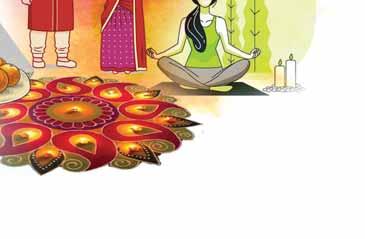
Students and Rotarians on either side prepared both the dishes up to perfection, all working together, thanks to the wonderful zoom platform. At the end of three special virtual meetings, all the students and attending Rotarians were able to perform basic yoga and pranayama under the able guidance of an Indian yoga teacher. They also learnt Indian dance basics from a reputed dance teacher. Mexican students enjoyed a virtual tour of Goa, with the kind help of the Rotaract Club of Vasco da Gama. The inbound programme was closed with sharing of experiences by Mexican students about their inbound visits. All the six students were felicitated with a certificate of participation from district 3132. Select meetings were blessed by district leaders on either side. The outbound visit for district 3132 students was equally interesting. Mexican RYE chair Erika had planned a wonderful programme for all the six students. Everyone learnt to prepare the Mexican Cocada and Enchiladas easily on zoom, thanks to the enthusiastic local Rotarians. Learning Mexican history, details of the ‘Day of the Dead’ tradition was quite interesting. Celebrating
I think the virtual RYE is here to stay. There are various reasons for it. It is equally great fun as that of a physical exchange.
Christmas by preparing Piñatas was great fun for all of us.
While closing the virtual RYE, the students were in tears and the Rotarians were equally moved. But the assurance of a physical exchange in July 2022 onwards changed the mood of the meeting. Not only an RYE but also a Rotary Friendship Exchange was also planned between these two districts by the attending Rotarians. A twin club agreement between the Rotary Club of Solapur North, RID 3132, and the Rotary Club Las Lomas, RID 4170, was the icing on the cake of this virtual RYE. Overall, it was a wonderful, unique and memorable lifetime experience for not only the RYE students but also the Rotarians from both districts and families.
Now I am a converted man! I think the virtual RYE is here to stay. There are various reasons for it. No travel, no risk, practically no hassles. It is equally great fun as that of a physical exchange. The students from lower socioeconomic strata can even participate and enjoy it, as there are negligible expenses. So my request to Rotary International will be to continue virtual youth exchanges even after we start physical exchanges from July 2022 onwards.
The writer is a member of RC Solapur North, RID 3132
Illustration: Sanjay D
Kiran Zehra
Dvisually-impaired chess player who recently won a chess tournament hosted by RC Bangalore (RCB), RID 3190, at Rotary House of Friendship, the club’s auditorium.


o you play chess? Try playing it blindfold,” says Shashidhara KM, while sharing details for this article. He tries the following routine each time he is on his way to a chess tournament — jumping with the knight across the entire board, working out the shortest route from one square to another. “For example, what is the best way for my knight to make it from b1 to g8? It helps me prepare for my game,” says the
For the visually-impaired player “the game is all about visualisation, imagination, calculation and touch. The touch of the pin on the pieces helps the player from distinguishing a white piece from a black one and can also determine whether the piece is a pawn, rook, bishop, knight, queen or king.” A special chessboard is used where the squares on the braille board are raised and have dots on them to identify the different squares on the board. The player is, therefore, able to have a clear picture in her mind of the position on the board. And a special clock keeps note of the time each player has taken to make a move.


The one-day Speed Chess Tournament for the visually-challenged was organised in association with the Karnataka State Chess Association for the blind, and 34 players from Bengaluru, Raichur, Mandya, Bagalkot, Mysuru, and other cities, pitted their skills against each other
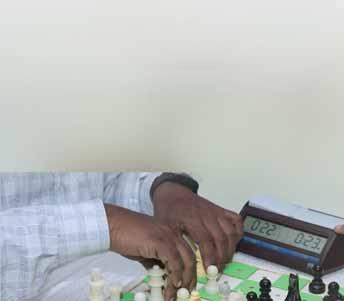
Chessboard designed especially for the visually-challenged.
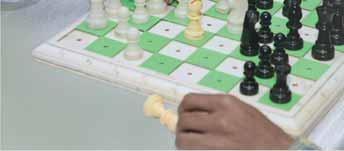
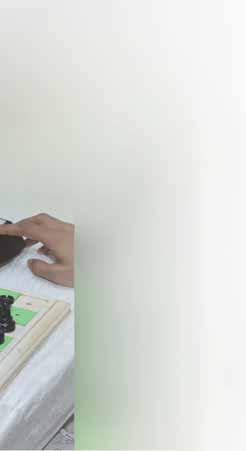
We chartered RC Bangalore Abilities (RBA), probably one of the few Rotary clubs in the world that is formed of disabled members, doing work for the disabled. in a Swiss League format. Here no player is eliminated and the winner is chosen on the basis of the highest number of moves in the time given. All participants received a certificate in Braille, while 10 winners were given cash prizes totalling `25,000.
Sandeep Ohri, RCB’s vocational services chair, says “Chess is the only game where the blind can play on par with the sighted. Not only is it interesting to watch but the accuracy with which they play is mindboggling.” In tandem with Rotary’s DEI policy, his club has been actively promoting “inclusiveness for the visually-challenged. We chartered RC Bangalore Abilities (RBA), probably one of the few Rotary clubs in the world that is formed of disabled members, doing work for the disabled!”


The club has also bought an annual subscription to a lifestyle Braille magazine for the members of RBA. “There are course and subject books, but the visuallychallenged have no access to lifestyle magazines or light reads.” When the club came across White Print,
a 64-page English monthly with a variety of articles on entertainment, leadership, fiction, news, sports, and current affairs, “making it truly an enjoyable experience for the visuallychallenged, we bought subscriptions for RBA members. They identified 25 institutions across Karnataka, who
Left: RCB past president Ranga Rao handing over the Braille certificate to Shashidhara KM winner of the tournament in the presence of (from L) Hari Priya Girish, Kalyani Talukder, vocational services chair Sandeep Ohri, club secretary Gowri Oza, Girish Ramanathan, Aria Ohri and Dr Dayaprasad Kulkarni.
will be given multiple copies of the White Print, for a year at a cost of `1.3 lakh and will benefit close to 1,000 visually-challenged people.”
Once the chess tournament had concluded, copies of the magazine were handed over to RBA president Aravind, who says “It’s entertaining as we will have more topics to discuss with the people we meet and the joy of owning something made exclusively just for our community is indescribable.”
Adialysis centre with two machines was set up at the JPM Rotary Eye Hospital by RC Cuttack, RID 3262, to help treat the increasing number of patients with acute renal disease. The work for the centre costing `34 lakh began last year as part of the club’s platinum jubilee celebrations. It received `10
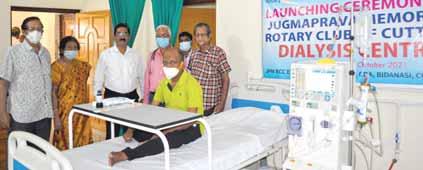
lakh from the DDF and balance funds was pooled in by the members. PRID Bharat Pandya, in his virtual address, congratulated the club for completing the project within a year. IPDG Saumya Ranjan Mishra, PDG AB Mohapatra and IPP Bindu Kumar Das dedicated the facility to the hospital. The hospital will charge
a nominal fee from patients for the facility and the amounted collected will be used to maintain it, said Das.
A Rotary Eye Hospital and Research Institute, an old age home, a play school and a geriatric healthcare centre are some of the projects done by the club in these 70 years of its charter.
Never underestimate the power of one’s dream, thought, idea, vision or a programme as it can have profound impact on the community or at the pan-India level, said RI President Shekhar Mehta at the golden jubilee celebrations of RC Madras Midtown, RID 3232.
To illustrate his point, he recalled his visit to the wedding of PRIP Kalyan Banerjee’s son 15 years ago in Vapi, a small town in Gujarat, which totally changed his mindset.
As he was wondering at the reason for holding the marriage at a Rotary school, “I saw one of the best manicured lawns at this school, a project of RC Vapi which had 54 members then. The town with 200,000 people had no school, so they started a primary school,
V Muthukumaran
and got it elevated into secondary school, which now has over 2,000 students. For higher education, a college was started back then. Now, this small town has seven colleges including a medical college with a 200-bed stateof-the-art hospital, all run by RC Vapi.”
That visit to Vapi, “I consider a pilgrimage,” said Mehta. Paediatric heart surgeries were taken up for the first time by RC Calcutta Mahanagar, his home club, with much hesitation, though the then president was a heart surgeon, as they were entering into uncharted waters. “We completed the year with 100 free heart surgeries against the target of 66 surgeries. This project then became our district’s flagship project, and I was personally involved in 2,500 surgeries, and now at the all-India level, clubs have done
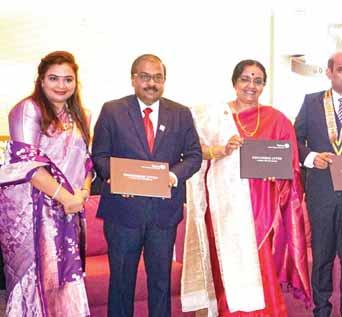
over 20,000 surgeries on poor children in the last 10 years.”
Only failures beget success
Honda Motors founder-chairman Soichiro Honda, Bollywood actor Amitabh Bachchan, American inventor Thomas Alva Edison, and US President Abraham Lincoln achieved the pinnacle of success after experiencing a series of failures in their life, he said. “A ship is safe in the harbour, but you have to take it to the high seas for it to live its life.” He urged the club to take up one single programme on a mega scale with a grand vision so that it can later be scaled up to the national level. Project Shelter Kits was pioneered by him to provide relief to disaster victims as it has 52 essential items such as tarpaulins, bedsheets, cooking and eating
RI President Shekhar Mehta and RI Director AS Venkatesh releasing the coffee table book. Also seen are (from L) Anuradha Jindal, club’s Foundation chair Jaisankar Unithan, service director Usha Kumar, president Vikram Jindal, golden jubilee events chair Ashok Kumar Shetty and secretary V Krishnacumar.


utensils, and other utility articles for a family to restart their life. It’s a sort of ghar wapsi kit, he said. Now shelter kits are being distributed wherever disaster strikes in India. “Reaching 50 years is a time for celebration indeed for a club, but it is also an occasion to introspect and rededicate ourselves for the cause of service,” he said. “It is a big gift to touch and change lives. Rotary has to keep the wheel rolling for humanity to thrive. We have the power and magic to serve to change lives,” he added.
Put together a committee of senior Rotarians to reassess the club’s priorities and chalk out a plan of action in the decades ahead, said RI Director AS Ventakesh. “You have to formulate a strategy for the next 10 years and avoid the sense of complacency that may creep in,” he said. The club has not touched even 10 per cent of its potential, hence “go for big targets like building a new hospital, school or setting up a vocational centre that can house 1,000 girls,” he advised.
Listing some of the milestone projects, club president Vikram Jindal said 1,400 sanitary pads were given to students at the Corporation Girls School, Choolaimedu; MHM sessions are being held at five schools, and 600 girls will be given sanitary pads for which a hygiene cupboard will be gifted to the schools; 100 boats with motors and nets were given to tsunami-hit fishermen at three villages in Kancheepuram district; two toilet blocks were renovated at the Corporation Boys School, Nungambakkam, which has an Interact club too; and funds were given for providing TV sets to Sri Lankan children for their education.
The club has taken up a ‘no plastic’ campaign at Kodai hills in partnership with RC Kodaikanal and is providing financial aid to nursing students at the Van Allen Hospital there.
Empowering women by giving them vocational training is one of their
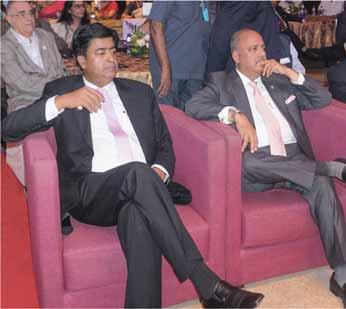

key initiatives, said Jindal. “Every month we want to empower 100 women by providing them training in home-made products such as chocolate, cloth and paper bags, manure and pickle making,” he said. For TRF giving, the club had set the bar at $100,000 — $50,000 as a golden jubilee Endowment Fund and the balance for the GG project of setting up a five-machine dialysis unit at the Ayyappan Seva Samajam in Arakamedu village, Tiruvallur district. The club is a partner for a global grant to procure a mobile mammography clinic for which it will contribute `3 lakh and provide cancer care.
In partnership with the Indian Maritime University, the club is into a mega greening mission with a target to plant 50,000 saplings in and around Chennai. “We are creating a Miyawaki forest over 40 acres allotted to us at the IMU campus where we will plant over 2 lakh trees in the next three years,” said Jindal. The club runs two Orange Vision Centres at Tiruttani and Karnodai (Red Hills) and three more will come up this year at Santhome, Ponneri and Minjur.
District Rotary Foundation chairman M Ambalavanan and Ann Geetha were felicitated by Mehta for becoming AKS members. Recalling his stint as club president in 2016–17, Ambalavanan said completing three GG projects brought “pride and prestige to the club”. “From there on, we are able to get global donors and TRF funds for our projects. This cemented my conviction and strengthened my resolve to give more to the Foundation. Rotary has brought transformational changes in society, and transcendental changes in ourselves. We can feel the magic,” he said.
RC Madras president Mohan Raman said his club will be setting up a tailoring centre jointly with RC Madras Midtown. “The staff at our centres at Selaiyur and Rotary Nagar, Triplicane, will train the instructors at the newly set-up vocational centre. We will donate sewing machines worth `2.5 lakh for the project.” A coffee table book Touching lives, a Madras Midtown journey curated by past president Usha Kumar was released by Mehta. Event chair Jaishankar Unithan also spoke.
Pictures by V Muthukumaran








The Rotary Club of Nasik Road and RI District 3030 hosted the second edition of a virtual International marathon, cyclothon and walkathon on November 14, 2021, to raise funds to provide digital classrooms for children studying in rural schools. The event saw 800 participants from almost all states of India and many other countries as well. It was planned in such a way that all the participants could walk, cycle or run their chosen distance at any time on the scheduled day wherever they were in the world, either individually or in small groups maintaining the regulations in force for the pandemic situation. This event was the brainchild of PP Rtn Mahesh Salve, himself an avid runner and president Dr Snehal Gangurde. A committee of Rotarians took care of the planning and implementation. Many runners and cyclists’ associations throughout RI District 3030 supported the event and helped to achieve the frequently raised targets for participation. Social media was abuzz with the event details and information for almost a month with all Rotary and nonRotary groups being flooded with appeals for registration, videos of participating local icons and brand ambassadors, district dignitaries including PDGs, DGEs, DGNs, AGs, etc.
The club’s Facebook page was also updated several times a day with the latest news of the event and was liked by a large number. Nearly 50 lakh persons were made aware of the event making it a huge PR exercise for the club. IPP Dr Amit Gangurde, past presidents Hemant Shidhaye, Vibha Patil and Firdaus Kapadia contributed their efforts and time to make this event a success. They were ably guided and assisted by DG Ramesh Meher and President Enclave Chair PP Sanjay Kalantri.
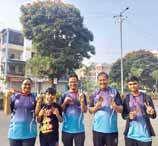

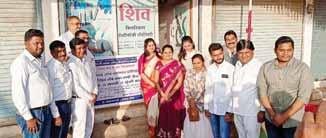
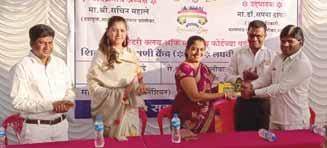
Rotary Club of Malegaon Fort recently set up a pathological laboratory at Shiv Lab. The lab, inaugurated by the municipal corporation health officer Dr Sapana Thakre, will extend 40 per cent concession for its services for underprivileged people. In her speech Dr Sapana stated that the Rotary club has been significant with its welfare activities in Malegaon Fort. Deputy Commissioner of Malegaon Municipal Corporation Sachin Mahale presided over the event. He too lauded the admirable work of Rotary Malegaon Fort on its health and education activities and promised the support of the corporation for the club’s welfare activities. Club president Arun Pathade felicitated health officer Dr Sapana and commissioner Mahale, pathologists Sagar Pawar and Satyam Nikam with copies of the Bhagwad Gita. This programme was anchored by Dr Narendra Thoke. Project manager Kavita Kasliwal detailed the gathering about the project and club secretary Nilesh Patil delivered the vote of thanks. Club members Shashir Hire, Sarjerao Pawar, Vijayalaxmi Ahire, Shippa Deshmukh, Sagar Lonari, Amit Khare and RAC Malegaon Fort president Nilesh Pathade and other Rotaractors were present at the event.

Rotary club of Nagpur Metro and the Central Neurological Medical Institute (CNMI) have jointly started the ‘one of its kind’ project of free medical consultancy for senior citizens above age 65. This project was inaugurated on Dec 29, 2021 by orthopaedic surgeon Dr Sudhir Babhulkar. CNMI founder and director Dr Shyam Babhulkar’s mother Pramilatai Babhulkar (age 96 years) graced the occasion with her presence and blessed the project. Under this project, neurology, orthopaedic, cardiology, ophthalmology, dental, skin, ENT and homeopathy consultancies will be provided free to senior citizens above 65 yrs on every Wednesday between 3 to 6 pm. Specialised doctors will offer their services.
Club president Satish Dande welcomed Dr. Sudhir Babhulkar with a floral bouquet. Mrs Seema Deshpande greeted Pramilatai Babhulkar; Rtn Aashish Rewatkar welcomed Dr Shyam Babhulkar with a floral bouquet. Dande briefed the audience about the project. Rtn Ramesh Borkute, introduced the chief guest Dr Sudhir Babhulkar. Rtn Sandhya Dande compered the programme.
Dr Sudhir Babhulkar appreciated the project and suggested the organisers to extend it for more days in a week as per the response of senior citizens. He also appealed to the doctors of the city to join this venture and congratulated the organisers. Dr Shyam Babhulkar also congratulated the club for the venture. Dilip Patne presented the vote of thanks.
AG Virendra Patrikar, Rotary Enclave Chair Kishor Rathi, Dr Shirpurkar, Dr Akulwar, Dr Manohar Muddeshwar, Dr Adil Chimthanwala, Dr Rashmi Babhulkar, Dr Sayali Bhave, Dr Kiran Saoji, PP Mahesh Singh, Nishant Mishra (Secretary, Metro club), Ramesh Borkute, Sukhadev Yeole, Gaidhane, Mahesh Mahale, Sanjay Thakre, Girish Dhond, Devendra Verma, Brij Chandak and other club members were present.








Rotary Club of Jalgaon Midtown formed a Rotary Community Corps with students of Domgaon ZP School, Pachora Jalgaon. The club donated a water filter, two ceiling fans, drawing books, crayons and pencils to the needy students of the school. Mr Tayade, Kendra Pramukh and village sarpanch graced the programme. Dr Aparna Makasare spoke on women’s empowerment and Rotary’s role in leadership development. Vishwas Thakur, head master of the school, explained the challenges faced by the rural students and presented the vote of thanks. Club member Kishor Patil donated the water filter to the school so that the studens and staff will have access to clean drinking water. Club president Dr Vivek Vadjikar, honorary secretary Tariq Shaikh, Kishor Patil and Dr Aparna Makasare took efforts for the successful completion of project.















Till the day I’m alive and till Lata is there, she will always be my first choice,” composer Madan Mohan minced no words when Asha Bhosle once complained, “You give me ordinary tunes, but Didi your best tunes.”
SD Burman made the same point differently. “I always considered Lata as my first serve and Asha as the second. The moment




the first started working again, there was no need to use my second serve.”
Even SD Burman’s son RD Burman (Pancham) — who married Asha and boosted her career with numerous chartbusters — looked upon Lata with awe and placed her on a pedestal. He remarked: “If Asha Bhosle is the Gary Sobers of music, Lata Mangeshkar is the Don Bradman.” Reacting to this, Asha said, “Perhaps what Pancham meant was that Didi is as





S R Madhu
controlled as Bradman was on the pitch, while like Sobers, I have taken more risks.”

Lata Mangeshkar! For musicians, the two words spelt perfection. For film historians, the name encapsulated seven decades of Bollywood music. But for the masses, it meant paradise — they got a
chunk of it every day through Lata’s songs on radio, TV, YouTube, Amazon or Apple music. They still do. Lata was venerated as Saraswati, likened to the Taj Mahal, the Ganges and the Himalayas. Her voice was stilled on February 6, 2022, but her soul lives in the many

Till the day I’m alive and till Lata is there, she will always be my first choice.
Music composer Madan Mohan


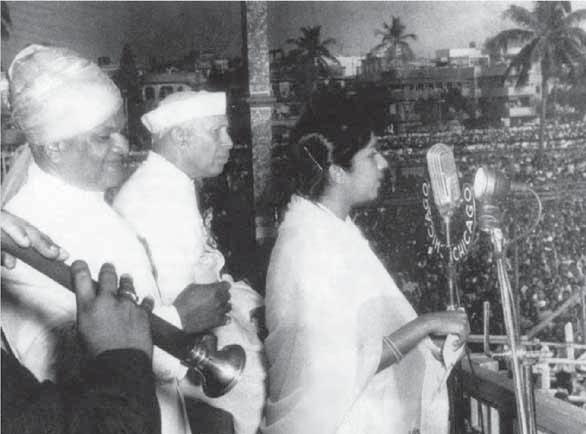
thousand songs she gave the world.
As India Today commented, “It is the voice to which the roadside vendor in Delhi transacts his business, the longdistance trucker speeds along the highway, the Army jawan in Ladakh keeps guard at his frontier bunker, or the glittering elite of Bombay dine in luxury hotels.”

Chennai, she didn’t like staying in a hotel and eating hotel food, so Sivaji Ganesan built a cottage for her in his house in Chennai.
Lata is the most decorated artist of filmdom — with a Bharat Ratna, a

Dadasaheb Phalke award, four Filmfare awards as best singer plus a special Filmfare award for lifetime achievement and three national awards. The Madhya Pradesh and Maharashtra governments have
instituted awards in her name. She enjoyed phenomenal success in her concerts abroad. Between 1975 and 1998, she conducted numerous shows in the United States, Canada, the Caribbean and the Fiji islands. They were always held in the most prestigious venues. Local American collaborators were sceptical about the large crowds predicted and the high ticket prices, but were amazed at the sellout crowds which even top American stars like Frank Sinatra couldn’t manage.

Lata’s childhood Lata was born on September 28, 1929 in Indore. The eldest of five children, her siblings were Asha, Usha, Meena





Composer Sajjad
Hussain once said, “Lata gaati hain, baki sab roti hain” (Lata sings, the others wail). A composer even suggested that “one should add two swaras — La and Ta — to the seven swaras of Indian music (sa, re, ga, ma, pa, dha, ni).”
At her peak, Lata’s clout was without parallel. During her visits to

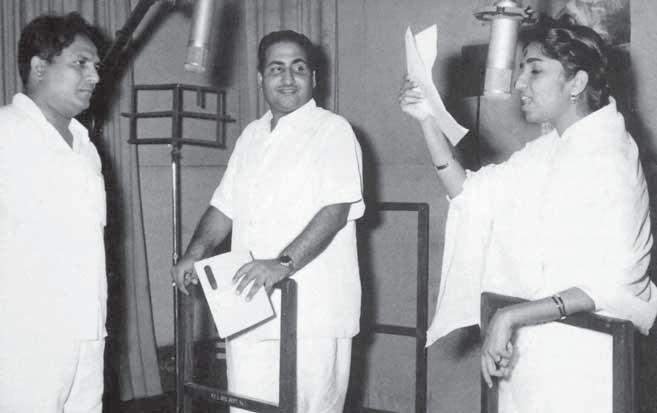
























and Hridyanath. Her father Pandit Deenanath Mangeshkar was a classical music singer who ran an itinerant drama troupe. It staged mythologicals in small towns of Maharashtra. The children lived a nomadic life and school was not possible. But “there was music in our house day and night,” recalls Lata. Film music was banned, however, the only exception being KL Saigal; Deenanath was his fan, Lata more so. She often hummed Ek bangla bane nyara.
Lata was a tomboy as a child, particularly in Sangli where the family lived in a large house. She told her biographer Nasreen Munni Kabir that she would climb trees
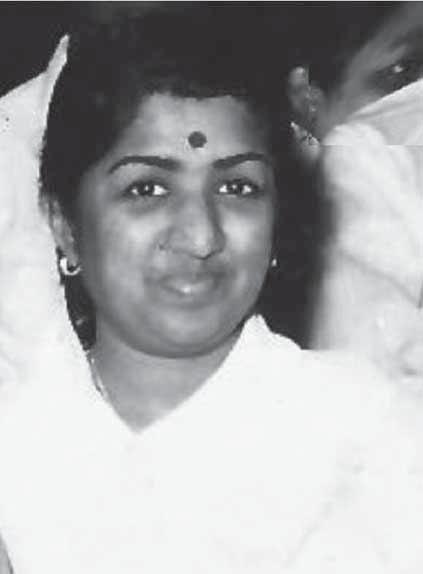
With Carnatic music legend MS Subbulakshmi.
and pluck mangoes and guavas; walk around with a stick and bully everyone; sit inside a car tyre and other boys and girls would roll it down the street; play cards and gilli danda.
Deenanath’s drama troupe was struck a severe blow by Indian cinema — when it began to talk, with Ardeshir Irani’s Alam Ara in 1934–35. The talking films drew crowds away from traditional drama companies. Several of them, including Deenanath’s, wound up, and never recovered. He made films himself, revived his theatre company, sold his house in Sangli, but he incurred heavy debts. And his flirtation
with alcohol did not help. He died on April 24, 1942.

Lata was 13, and became the breadwinner. A friend of her father, Master Vinayak (actress Nanda’s father) gave her a role in a Marathi film. At his prodding, she got trained in classical music by Ustad Aman Ali Khan Bhendibazarwale, and later by Amanat Khan Devaswale. Lata had an extraordinary memory and a sponge-like ability to absorb anything new. The training was valuable.
Lata acted in four Marathi films (in one of which she sang her first Hindi song) and four Hindi films. She disliked acting,
One can list the best of Lata’s songs in different ways — by composer; by mood; and by the heroines who lip-synched her songs. I’ll choose the last, to prove Jaya Bachchan’s point — that Lata enacted and emoted rather than just sang the songs. Here are some of Lata’s radiant gems for a few top Bollywood heroines.
Ayegaa, ayega anewala — Mahal (1949).
Composer: Naushad
Seene mein sulagte hai armaan — Lata and Talat Mahmood. Tarana (1951). Composer: Anil Biswas
Tere sadke balam — Amar (1954). Naushad
Mere sapne mein aana re — Rajhat (1954).
Shankar-Jaikshen
Pyar kiya to darna kya — Mughal-e-Azam (1960).
Naushad
Meri aankhon mein bas gaya koyi re — Barsaat (1949). Shankar-Jaikishen
Ghar aya meri pardesi — Awara (1951).
Shankar-Jaikishen
Ye shaam ki tanhaiyan — Aah (1953).
Shankar-Jaikishen
Rasik balma — Chori Chori (1955).
Shankar-Jaikishen
Pyar hua ikrar hua — Shree 420 (1955).
Lata and Manna Dey. Shankar-Jaikishen
Jaago mohan pyare — Jagte Raho (1957).
Salil Choudhury
Radha na bole na bole na bole re — Azaad (1955). C Ramchandra
O raat ke musafir — Miss Mary (1957).
Lata & Rafi. C Ramchandra
Ajeeb dastan hai ye — Dil Apna aur Preet Parai (1960). Shankar-Jaikishen.
Jyoti kalash chalke — Bhabhi Ki Chudiyan (1961). Sudhir Phadke
Inhi logon ne — Pakeezah (1972).
Ghulam Mohammed-Naushad
Manmohana bade jhoote — Seema (1955).
Shankar-Jakishen
Chand phir nikla — Paying Guest (1957).
SD Burman






Main to bhool chali babul ka des — Saraswatichandra (1959). Kalyanji-Anandji
Mora gora ang lei le — Bandini (1963).
S D Burman
Tera jaana — Anari (1969). Shankar-Jaikishen
Kahin deep jale kahin dil — Bees Saal Baad (1962). Hemant Kumar
Aaj phir jeene ki tamanna hai — Guide (1965). S D Burman
Tere mere sapne — Guide (1965).
S D Burman. Lata & Rafi
Rangeela re — Prem Pujari (1970).
S D Burman
All these Lata songs boosted the actresses and the films.
























but had no choice. She saved and scrimped to keep food on the family table — she walked long distances, even skipped meals herself.

An encounter with composer Ghulam Haider was the first important break in her life. He took Lata to producer Shashidhar Mukherjee, who was making the film Shaheed (starring Dilip Kumar and Kamini Kaushal), but he rejected Lata as singer saying her voice was too thin.
Irritated no end, Ghulam Haider resolved to prove him wrong. She sang the song Dil mera toda in Haider’s own film, and the song attracted much notice. Lata was engaged by Khemchand Prakash, then Anil Biswas, and by Naushad himself.
The year 1949, when Lata was 20, was a breakthrough
year. Ayega aanewala in Mahal (directed by Khemchand Prakash) was a sublime delight, and created a sensation. Listeners deluged All India Radio for the name of the singer (which was omitted from the record as was the practice those days) and the producers finally revealed it. Lata was no more the obscure small-town girl struggling for recognition.
1949 was also the year when Lata sang Uthaye ja unke sitham, a masterpiece of melancholy, for Naushad in Andaz (a huge film that starred Nargis, Dilip Kumar and Raj Kapoor). And in the same year, Raj Kapoor’s Barsaat hit the screen, with music by Shankar-Jaikishen. The film had eight songs by Lata, each of them a gem. “The barsaat in Lata’s career never stopped after that film,” said composer Shankar.

With music composer AR Rahman.
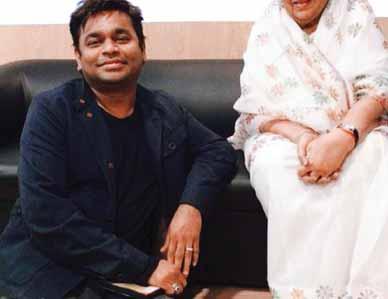

Clockwise: Sharing a lighter moment with composer RD Burman With music composer SD Burman Lata with her sisters Meena and Usha A young Lata With Naushad, Mohammed Rafi and Majrooh Sultanpuri Raj Kapoor, Lata and Geeta Dutt.
A Lata tsunami hit Bollywood in the 1950s, impacting all musiclovers and sweeping away all other rivals. She scaled heights of popularity Indian cinema had not seen till then. “I recorded two songs in the morning, two in the afternoon, two in the evening and two at night,” she told her biographer Nasreen. She got home at 3am and that’s when she ate. Incredible as it may sound, Lata says she didn’t know that some studios had a canteen where all others ate. “After a few hours of sleep, I would wake up at six, get dressed, catch the train and travel from one recording studio to another.”
Throughout the 1950s, Lata’s celestial voice was heard in many immortal melodies. This was the decade when some top composers — Shankar-Jaikishen, Naushad, C Ramchandra, SD Burman, Hemant Kumar — were at their peak. She sang one gem after another in Awara, Aah, Baiju Bawra, Shree 420, Anarkali, and other films.
The 1960s were the most prolific decade for Bollywood music — “sizzling, swinging, scintillating

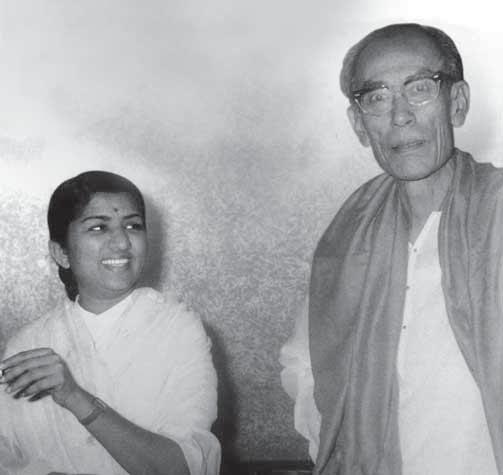

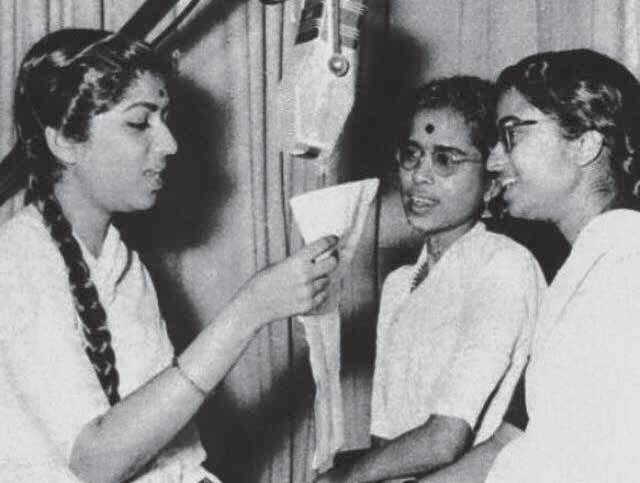
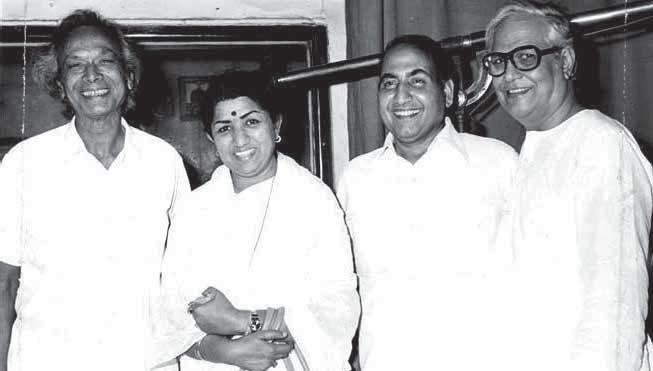
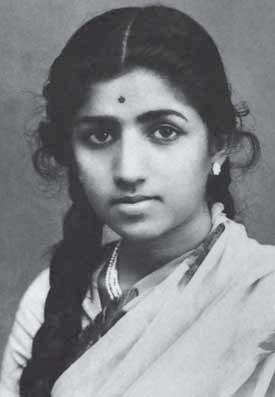
























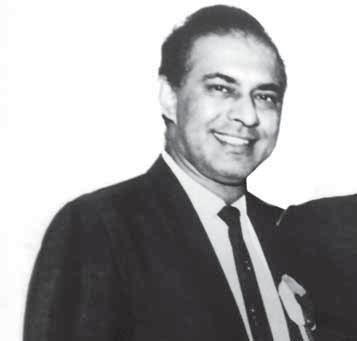

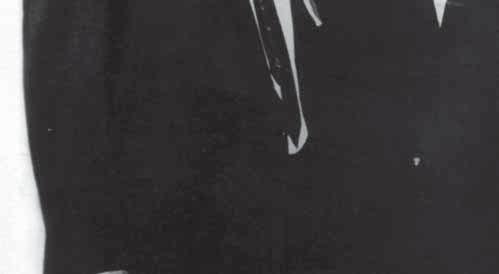
Lata with Talat Mahmood, Mukesh, Rafi and Manna Dey.
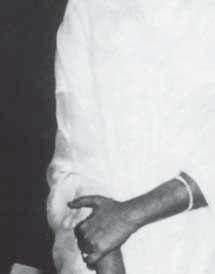
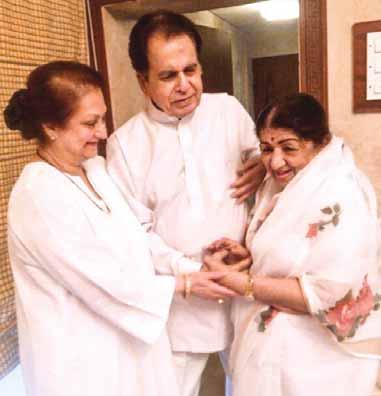


and superlative”, to quote Rajiv Vijayakar. Lata began the decade with a film of massive magnificence (Mughal-eAzam), where Naushad, Lata and Madhubala combined to offer a heavenly aural and visual cocktail. Dev Anand’s Guide was another musical triumph, created by Dev Anand, SD Burman, Lata and Waheeda Rehman. Lata’s songs filmed on Waheeda — Aaj phir jeena kitamanna hai, Piya tosey naina laaei re — and the Lata-Kishore duet Gaata rahe mera dil were eternal charmers. She excelled again in films such as Junglee, Asli Naqli, Ganga Jumna, Mere Mehboob, Anpadh, Mamta, Mera Saaya — to mention just a few.
Her foremost films in the 1970s were Bobby, Abhimaan, AmarPrem and Aandhi. She


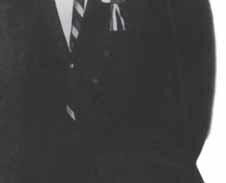

Shankar-Jaikishen, 331 for RD Burman, 302 for KalyanjiAnandji, 288 for C Ramchandra, 210 for Madan Mohan.
She was full of praise for Shankar-Jaikishen who brought a new grammar to Hindi film music, and to Naushad, for his uncompromising excellence. They played major roles in her dizzy ascent to the peak. But she had a special relationship with Madan Mohan, who used to tie a rakhi on her hand every year.
After a few hours of sleep, I would wake up at six, get dressed, catch the train and travel from one recording studio to another.
Her Madan Mohan melodies had an ethereal sweetness, something Khayyam said he was envious of. These included Meree veena tum bin roye (Dekh Kabira Roya), Hum pyaar mein jalne walon ko (Jailor), Yoon hasraton ke daag (Adalat), Aap ki nazron ne samjha (Anpadh), Naina barse (Woh Kaun Thi), and Nainon mein badra chhaye (Mera Saaya).
Madan Mohan’s son Sanjeev Kohli collaborated with Yash Chopra and Lata Mangeshkar to make the film Veer Zara (2004), about an Indo-Pak love story. Its music was based on unused tunes of Madan Mohan which Kohli discovered. Lata was in tears whenever she took the mike for recording the songs of the movie. The Veer Zara album was the highest-selling album of the year.

brought success back to the RK camp in Bobby after the crushing failure of Mera Naam Joker, which had almost made Raj Kapoor bankrupt. Lata at 45 sang for the 15-year-old Dimple, and sounded 15 herself. Bobby triumphed.
Abhimaan, a film about a musician couple, had some surpassingly beautiful songs by Lata. So did Amar Prem. She sang some classical pieces of transcendental beauty for RD Burman — such as Raina beeti jaaye (Amar Prem), Beeti na beetayi raina (Parichay), Tere bina zindagi (Aandhi), and Baahon mein chale aao (Anamika).
Lata’s relationships with composers
Lata sang 696 songs for Laxmikant-Pyarelal, 453 for
Lata Mangeshkar as told to her biographer Nasreen Munni Kabir
Lata sang more often for Laxmikant-Pyarelal than for any other composer. In fact, she said the initials LP stood for “longplaying”, because of the longevity of their careers (they composed music for nearly 500 films). She first sang for LP for their film



























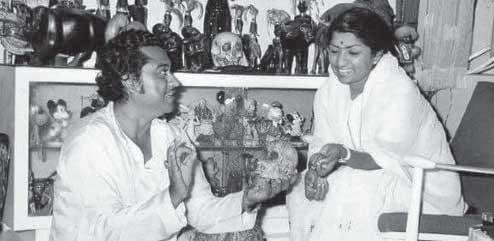
Parasmani. For the song Hansta hua noorani chehra in this film, LP used 36 violins; it was a spectacular success.
“Our first choice was always Lata,” said Pyarelal, “whether the song was filmed on a child, a sister, a mother or a grandmother.”
Lata has inspired hype as a singer, but she has also been branded as ungenerous and scheming in putting down young rivals — such as Vani Jairam, Runa Laila, Sulakshana Pandit, Preeti Sagar, Anuradha Paudwal, Hemalata, and even her own sister Asha. It is said that Lata would blacklist or subtly harass composers who gave these youngsters a chance. They would get the message! Lata responded that genuine talent can never be kept down, and that it requires guts and stamina to survive as a singer.

Lata being felicitated by Tamil film icon Sivaji Ganesan whom she used to call ‘anna’ (brother).
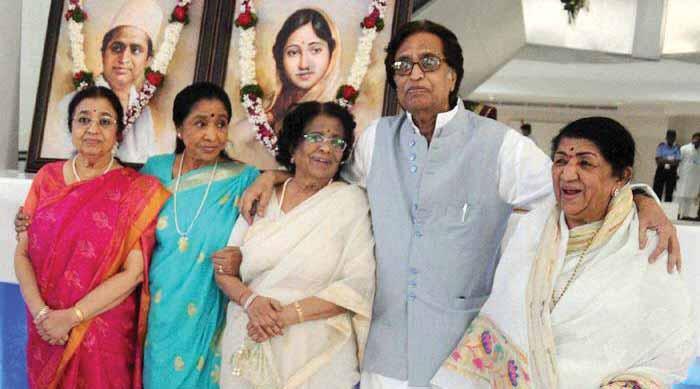




She said that she and Asha have always been the best of sisters. There was friction between them when Asha eloped with a much older man and married him. He forcibly kept Asha away from her family. But Asha quit an exploitative marriage and returned to her family.
Lata had a tiff with Mohammed Rafi on the question of royalties for singers. She insisted on royalties — a stand which has since benefited all playback singers, but Rafi didn’t agree. Discussion on this topic got heated, and the two didn’t sing together for six years.
Lata and Raj Kapoor also parted company on the question of royalties. But the veteran accepted Lata’s demand when he was making Bobby.
OP Nayyar is the only composer to have never used Lata for his songs. OP says Lata’s voice is thin and doesn’t suit his songs. There have also
Lata’s charity concert for the victorious Indian World Cup team of 1983 enabled an award of `1 lakh to each member of the team.
been misunderstandings with C Ramchandra and SD Burman.
Her passions
Lata was surprisingly a huge cricket fan. Her charity concert for the victorious Indian World Cup team of 1983 enabled an award of `1 lakh to each member of the team.
She liked cars, was a photography buff with an astonishing collection of professional cameras and an excellent portfolio, was fond of diamonds, always wore white sarees, adored good food (including ice cream and pickles
which are normally taboo for singers). She was happily unmarried all her life, and said she loved children but enjoyed the company of her siblings’ children.
The magic of Lata “What we classical musicians take three hours to do, Lata Mangeshkar achieves in just three minutes,” remarked Bade Ghulam Ali Khan once.
Her biographer Nasreen said “She could be wide-visioned and tunnel-visioned at the same time. You need both — the big picture and the detail.” Dilip Kumar said, “Lata resides in all of us.” Her voice has been stilled, but the soul of music lives on.
The author is a senior journalist and a member of the Rotary Club of Madras South
Photo credit: Niyogi Books, Popular Prakashan, NDTV Photos
Designed by Krishnapratheesh S








Areligious delegation from RC Mansa Royal, RID 3090, led by PDG Prem Aggarwal and accompanied by club president Kaman Goyal visited Kartarpur Sahib Gurudwara in Pakistan. This is one of the most sacred places for Sikhs as Guru Nanak Dev spent his last 18 years here and gave the message of the three pillars of Sikhism — Kirat Karni (honest living), Vand Chakna (sharing with others) and Naam Japna (focus on god).
The Kartarpur corridor was reopened in November 2021, and the
Rotary delegation was flagged off by the local gurudwara management committee after DG Parveen Jindal and Nalini Jindal and club members of RC Moga Stars arranged a delicious breakfast and bid them adieu from Moga.
The delegation of 20, comprising Rotarians, Anns and members of Inner Wheel Club Mansa Royal, and the Indian Medical Association, first visited the joint check post at the AttariWagha international border and the Sri Harmander Sahib Amritsar.

On Dec 1, the group departed for the Kartarpur Sahib after completing all
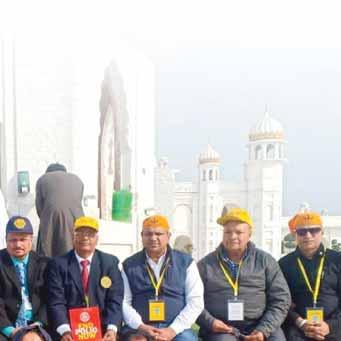
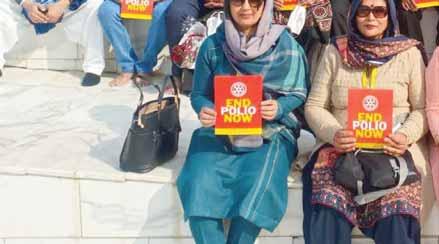
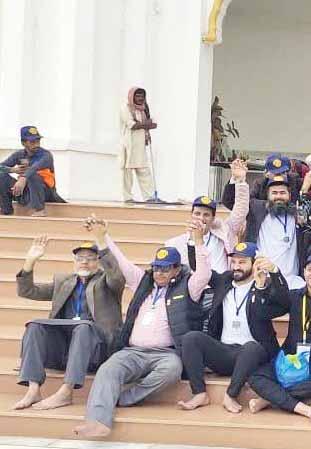
Above: RID 3272 DG Saifullah Ejaz, RID 3090 PDG Prem Aggarwal and RID 3272 DGE Saboor Rohaila with Rotarians from Pakistan and India at the Kartarpur Sahib Gurudwara.
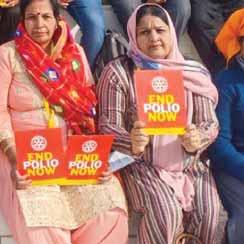


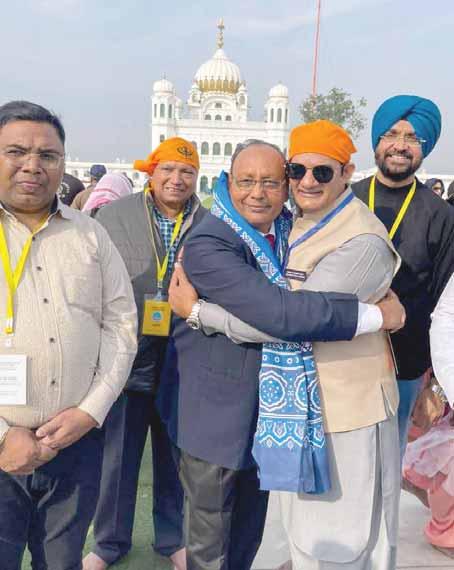
the customs, immigration and security formalities at both India and Pakistan checkposts, reached the gurudwara in Pakistan and offered prayers.
After taking food at the Langar Ghar, they visited the well which was used by Guru Nanak Dev for irrigating his fields.
As scheduled, a delegation of 82 members, including women, from 32 Rotary clubs of RI District 3272, from Lahore, Islamabad, Peshawar, Narowal and Rawalpindi, led by District Governor Saifullah Ejaz, visited the Kartarpur Sahib to welcome the Indian delegation from RID 3090.
Apart from the DG’s spouse Sidrah Saif, DGE Saboor Rohaila, PDG Faiza Qamar, and other senior Rotarians from Paksitan greeted the Indian visitors and welcomed them with gifts. “This was a great get-together to enhance the public image of Rotary, create awareness about our efforts at polio eradication and give out a message of peace and brotherhood between the people and Rotarians of
PDG Aggarwal, DG Ejaz and DGE Rohaila with Rotarians of India and Pakistan.

both the countries,” said PDG Prem Aggarwal. “On behalf of our DG, Parveen Jindal, I invited them to visit India and they accepted the invitation and assured us they will make a visit during a Rotary event.”
DG Ejaz said that in Pakistan the previous year, there was only one case, and in January 2022, the country has marked 365 days without a single case. Polio caps of India and Pakistan were exchanged.
PDG Bagh Singh
Pannu, RI District 3090, is on a mission to gift busts of Rotary founder Paul Harris to Rotary clubs across India which have their own buildings, schools or hospitals to display the busts. Till January end he had already gifted 151 busts to clubs in several districts in Punjab, Haryana, Jammu and Kashmir, West Bengal, Himachal Pradesh, Madhya Pradesh, Karnataka, Rajasthan, Andhra Pradesh, Chandigarh, Odisha, Maharashtra, Goa, Assam, Nagaland and Karnataka.
“The Paul Harris busts that I gift measures 3ft

by 2ft and is made from black metal. The project is entirely funded by me and it was my pleasure to install these busts in RC Calcutta and RC Chandigarh, the two landmark clubs that have given RI presidents from India — the late NC Laharry and Rajendra Saboo,” he said.
Recently Pannu has installed 22 Paul Harris busts in RID 3170 (comprising Goa, Karnataka and Maharashtra); the coordinator of this project is Narinder Barwal from RC Hubli (Karnataka). He hopes to install a total of 800 Paul Harris busts.



During a two-day visit to Dhule in northwestern Maharashtra, bordering Gujarat, RI President Shekhar Mehta inaugurated a slew of service projects being implemented by Rotary clubs in RID 3060. A dental clinic for the prisoners at the Central Jail, Dhule, was inaugurated by Mehta in the presence of RI director Mahesh Kotbagi, DG Santosh Pradhan and legislator Kunal Patil. The project was done by RC Dhule Femina in partnership with the Jawahar Medical Foundation.
Project Suvidha at the Civil Hospital, Dhule, is another grand project ( ` 35 lakh) which has helped set up a drinking water station, borewell, constructed toilet blocks, installed
dustbins, and given a facelift to the hospital park, apart from providing benches and cleanliness plaques on the premises. The project was inaugurated by Mehta in the presence of DG Pradhan, RID Kotbagi, district magistrate Jalaj Sharma and Dr Bhadange, civil surgeon. A mammography van, a GG project of RC Chikhli and 17 other clubs, was flagged off at the Dhule Charitable Society.
Project Sanjeevani from RC Dhule Cross Road has set up a pathology lab, physiotherapy centre and an ambulance through a global grant. Mehta distributed 25 sewing machines and virtually inaugurated a women’s empowerment centre and a Happy School. Dhule
mayor Pradeep Kharpe felicitated Mehta and Kotbagi. A commitment for three Endowment Funds worth $100,000 was given by Rotarians at a dinner reception given to Mehta and Kotbagi. The district also pledged to sponsor 1,000 Asha Kiran students in this Rotary year under the Rotary India Literacy Mission.
Mehta presided over a foundation laying ceremony for late Rtn Atul Ajmera Memorial Rotary Cross Road Vocational Centre. The visit of RI president was made possible with the efforts of DRFC PDG Ashish Ajmera, past president, RC Dhule Cross Road, and he was supported by other club members in this endeavour.
Managing his company, and playing a mentoring role in the pharmaceutical sector takes up much of his time, but that does not hinder RtnSV Veeramani from giving back to society what he has received from it. “It was IPDG S Muthupalaniappan (2020–21) who inspired me to give to The Rotary Foundation. But when I was DRFC during the tenure of PDG Raja Seenivasan (2012–13), my team really worked hard to get two AKS members andcommitment from two more Rotarians to join the elite club soon, ” he recalls. At that time, PDGs Seenivasan, Jawarilal Jain, RID 3231, and Rtn Ganesan from RC Maraimalainagar joined the AKS club. “I gave $120,000 to TRF and kept on adding $10,000–20,000 each year from then on.Last year (20–21), my total cumulative giving to TRFcrossed $250,000, to take me to the AKS level.” His total contributions stand at $290,000 at present.
Looking back at his 25-year Rotary journey, Veeramani, a member of RC Adyar, RID 3232, says, “it has been a thoroughly enjoyable one as I carry pleasant memories of friendship, fellowship and being part of many community projects. My association with Rotary will be lifelong.” The founderchairman of Fourrts India Lab, exporters of drug formulations and a major pharma player, says that hiswife, Radha, who isthe JMD, “has been very supportive, inspires me and is behind all the decisions I have taken in my life.”
What attracts him to Rotary is its larger philosophy of supporting the community through “bonding with fellow Rotarians as we all come together for a noble cause to do good in the world.” The couple has two daughters, Dr Gayatri and Dr Nitia.
Veeramani was the past president of the Indian Drug Manufacturers Association and “I also provide mentorship to pharma companies and startups.”
V Muthukumaran and Kiran Zehra

He will be taking over as chairman of the Pharmaceuticals Export Promotion Council of India (Pharmexcil) next year. “As Pharmexcil vice-chairman, my work is hectic. But being a Rotarian is a great experience, asTRF, district governors and club presidents do some really bigprojects in health, education, environment, women and child welfare,” he smiles.
A passion for giving
Why should a Rotarian contribute to TRF? Listening to Rtn Natanasabapathy Sundaravadivelu (Sundar) from RC Coimbatore, RID 3201, who was earlieraRotaractor, you are convinced that theFoundation grants play a great role in making the world a better place. So far, he has given more than $260,000 (over `2 crore) to TRF. “Three years back, I decided to become an AKS member and my wish was fulfilled last year (2020–21). The inspiration to join the elite club came from within,” says
Sundar, a lawyer who joined Rotary 22 years ago.Waxing eloquent on the Foundation, he continues, “TRF is one of the foremost achievements of Rotary. It has brought fragrance into the lives of needy people in our communities; and all Rotarians and others who have contributed to TRF have lit lamps within their own hearts.”
Jogging down memory lane, he recalls that being a GSE team member (1986–87) has “changed my entire outlook on life.” Till then, he had been a DRR and an active Rotaractor from 1976. His wife SV Murugambal, also a lawyer, has also contributed to TRF. “You can say our entire family has given to TRF as we are all earning members.”
His son Pravin Rathinam, a lawyer, and daughter Preethi who runs a pharma business, have also chipped in with their contributions. A DGND, Sundar is looking forward to his stint as DG in 2024–25. “My family will
continue to give to TRF as it is doing noble projects for the welfare of humanity,” he says.
Rotary’s goodwill is magical For Ambalavanan M donating to charities “is an addiction. But TRF’s transparency, prudence and high stewardship inpsired me to become an AKS member. When you donate $105 to Rotary you know that $100 will be given to the actual project and $5 will be used as processing fees, unlike other organisations that use 20–25 per cent of the donated amount for admin expenses. As a DRFC I know how TRF uses my dollars.”
A member of RC Madras Midtown, RID 3232, he believes that “Rotary is better than religion. The discipline that the Four-Way Test brings into your life is amazing.”
The goodwill of Rotary as a brand, he says, is “magical! It can make almost anything happen!” His most memorable moment in Rotary was during 2013, when as club president, he “organised and executed the Kashmir to Kanyakumari cycling rally, where 22 participants rode 4,800km, through
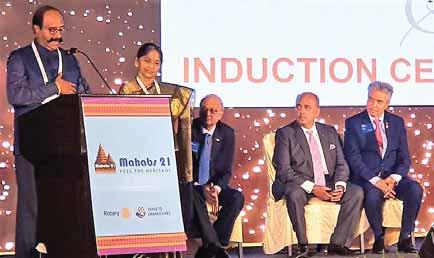
DGND Natanasabapathy Sundaravadivelu giving his acceptance speech at the institute in the presence of his spouse Murugambal, TRF Trustee Gulam Vahanvaty, RI President Mehta and Trustee Memon.
the changing landscape of India, to promote Swachh Bharat and WinS.”
Ambalavanan himself rode 700km along with the participants and “it was an adventure that led us to organising a cycling event Tour de Rotary in 2014 and 2015. Tamil Nadu DGPSylendra Babu, then ADGP, who participated in that event was so inspired by the sporting activity that he spoke to our current chief minister MK Stalin to lay a cycling lane in Chennai. We have one
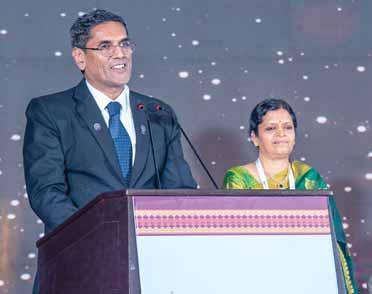
now,” he beams. He is also a member of Rotary’s Global Yoga and Meditation Fellowship and devised the Rotary World Peace Minutes programme, “a 10-minute initiative to promote meditation and prayer for peace.”
He has donated $175,000 and has committed to contribute $25,000 more to the TRF this year, and another $50,000 next year. In addition to that, he has donated $100 to TRF’s Environment Fund. Since 2015 he is a member of the Paul Harris Society (PHS).“I was the first Rotarian from RID 3232 to join the PHS. There is lack of knowledge about the Foundation programmes and the various funds. I want to train and mentor Rotarians on this subject.”
His way of inspiring people to give to TRF is “not traditional. I don’t ask people for a single dollar. I talk to them about some of the great projects made possible by the Foundation and show them how their investment can multiply the good work done by TRF.” Geetharani, his spouse, is “a highly spiritual person and she helped me understand the value of service better. She is supportive of my decision to give to the Foundation,” says Ambalavanan.
Jaishree
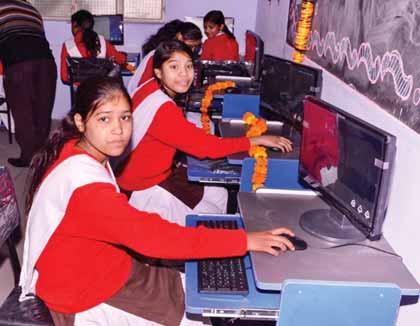
The 100-odd members of Rotary Club of Muzaffarnagar Midtown, RID 3100, are committed to transform government schools in Muzaffarnagar, UP, to make learning a fun experience for students. Since its charter in 1998, the club has always given priority to literacy, says assistant governor Sameer Agrawal.
The club has covered 70 government and government-aided schools with its literacy-related projects in these 24 years.
“We have constructed or renovated toilets in 30 schools, set up computer labs with 5–7 computers in each of the 25 schools, and e-learning facilities, handwash stations and water coolers in 50 schools,” says past president Suneel Agarwal, a member of the club since 2005. The club has provided classroom furniture and ceiling fans to 30 schools and “we regularly visit these schools to distribute stationery, school uniforms and footwear for the students,” he adds.
Regular MHM workshops are conducted for adolescent girls and sanitary pads are distributed to them. Sanitary pad vending machines have been installed in some of these schools. The club members pool funds to pay the school fees of students whose parents cannot afford to do so. Bicycles are gifted to children who travel to school from far-off places. “We had availed global grant support for some of these projects. In the next five years we want to make all these 70 schools Happy
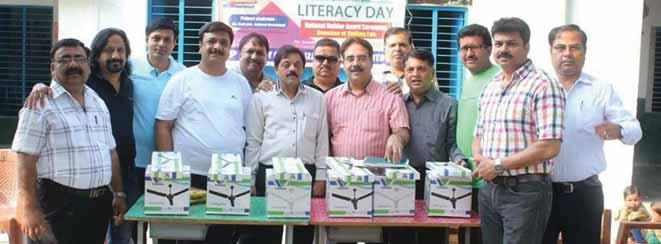
Schools,” smiles Agarwal who plans to become a Major Donor in the next two years by making a contribution of $10,000 to TRF.
The club has two global grants approved for this year. One grant is being used to set up a telemedicine centre at Sururpur Kalan village in Baraut district. The facility will benefit the large community of brick kiln workers in the area, he says. Another grant is used to install a dialysis facility at the government medical college hospital in the town. An e-learning centre is planned for a government school this year.
“The club is popular in the community for its literacy promotion activities and the image was further strengthened due to the 15 Covid vaccination camps it had organised in various rural
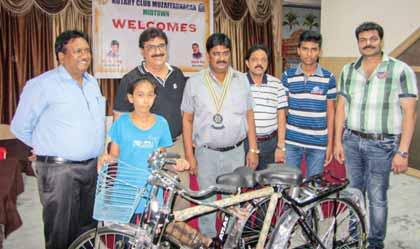
localities around the town,” says the assistant governor, adding that the club organises health camps at regular intervals, with extra emphasis on cervical cancer prevention.
The club has 27 Paul Harris Fellows who have each donated $1,000 to the Foundation and four of them have made multiple contributions to become MPHFs.

DG Prabir Chatterjee inaugurated a coaching centre, Panthaniwas E-Pathshala, established recently by RC Calcutta Jadavpur, RID 3291, at Dwaronda in Shantiniketan, Kolkata. The centre will provide coaching in all subjects for students of Classes 1 to 10 from
the surrounding four villages. The club has engaged five graduate students who will take classes for the children five days a week and the headmaster of the Dwaronda High School will visit the centre twice a week to keep track of the system. Light snacks will be provided
DG Prabir Chatterjee in discussion with Rotarians at the coaching centre.
everyday to the children attending classes at the centre.
An adult literacy programme will provide basic literacy at the centre to the domestic helps of the Panthaniwas complex. Reference books, notebooks and stationery were distributed to the students at the inauguration of the centre.
For malnourished and undernourished children in India, cheap yet protein-rich soya milk, which can be made at home at one-third the price of cow’s and buffalo’s milk, can be a great boon.
This idea was mooted by Ranjit Pal, the founding partner of Chetran Products, to RI District 3131 PDG Arun Kudale. He took this idea to members of his club, RC Pune South, and suggested they launch a pilot project in rural areas.
The first workshop was held in February 2021 at Ambavane village near Nasarapur, through the tireless efforts of Dnyan Prabodhini’s Suvarna
Tai. About 25 women anganwadi workers benefited from this training. These women are currently supplying soy milk to the students at the surrounding anganwadis. These women are compensated for their work through funds donated by Ranjit Pal, a retired bureaucrat from Maharashtra, to this club. He also gifted these women implements worth ` 10,000, and an additional `1 lakh to the club for this project.
“Till date, our club has conducted such workshops in 11 villages in several talukas. He has promised to give ` 20 lakh to our club to expand the reach of this project to benefit more malnourished children,” says Kudale.

These workshops, for between 10–25 women, are conducted in collaboration with the local gram panchayat office-bearers or the trustees of charitable organisations in the area. Club president Atul Atre and his team will be conducting 20 such workshops in different villages.
“While in service, he studied the food processing industry in Japan and while observing their family eating habits, he noticed that soybeans are widely used in food. Some babies or even adults cannot digest lactose in cow’s milk. Soy milk and other products can meet the protein requirement of human body at a lower cost than animal milk. Therefore, they are
Ranjit Pal, founder, Chetran Products, giving a mixie to a women’s group after the workshop in the presence of PDG Arun Kudale and the then president Sudarshan Natu.
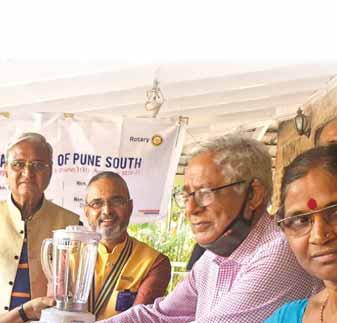



widely used in Japan, Pal noticed,” says Kudale.
Pal tried hard to convince the government to promote soybean products through consistent letters but to no avail. Finally, in 1990, in a home mixie, he made soy milk and tofu, based on the information gathered during his visit to Japan. He showed it at the Dorabjee Mall in a Pune camp. Dorabjee commented that the product would work well and gave him the first order.
According to Pal, soy milk is very easy to produce at home. This is the recipe.
Doing good with TRF help
Soak 1kg soybean seeds in 2 litres of water for 6 to 8 hours. Then grind it finely by adding water gradually until you make a 7-litre solution. Filter this liquid with a thin, fine-meshed cloth. The milk thus prepared is ready for further processing like usual milk. This milk can stay good for a few hours if heated. The residue left on the straining cloth can be used in cooking or as cattle feed, so there is no wastage. Adding curd or soy curd to the heated milk makes soy curd. Buttermilk, chakka or Shrikhand can be prepared from the curd, by adding preferred
flavour. Tofu or soy paneer can be made by separating water from solids in the soymilk by squeezing 1 or 2 lemons’ juice to boiling hot soy milk. After about 90 minutes, the segregation of solids takes place. The water is squeezed out by using a press, forming a solid slab. The dried solid is tofu. This is a great alternative to regular animal milk cheese. When used in vegetables, many people do not recognise the difference in taste between regular paneer and tofu.
For the rural women soy milk production workshops are held in simple local language, and notes are given.
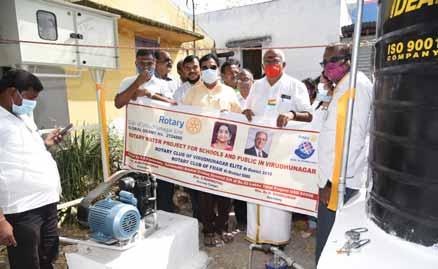
Around 750 residents of Rosalpatti village, a dry area hit by perennial water scarcity near Virudhunagar, Tamil Nadu, will
benefit from the four borewells dug by RC Virudhunagar Elite, RID 3212, through a global grant project worth $60,900. The club roped in RC Fargo
Moorhead AM, RID 5580, North Dakota, US, as its global partner for this Foundation project.
Motor pumps and storage tanks fitted with taps were installed for residents to draw water on a daily basis. The borewells, pumps and storage tanks will also provide clean drinking water and handwash facility to 10,000 students at eight schools in Virudhunagar, said C Marimuthu, the club’s primary contact. Besides the clubs, SS Ponnusamy-Saraswathi Ammal Trust has contributed a directed gift of `25 lakh for this project that benefits schoolchildren as well as villagers.
During the inaugural event, DGE VR Muthu dedicated one of the borewells to public usage. IPDG PNB Murugadoss, club president N Muthukumar and Marimuthu were present at the project site.

J Sridhar
Auto parts manufacturing
RC Madras Industrial City, RID 3232
Public image building is at the forefront of club activities as “our mega Covid vaccination camps across the city on Sept 12 and World Polio roadshows have created good impact among the people,” says J Sridhar. All the clubs have been supporting the efforts of Greater Chennai Corporation in holding vaccine camps through material and logistics support and “we have received a certificate of appreciation from the civic body for our partnership.”
A series of programmes such as roadshows, rallies, flash mob at malls, and poster and awareness campaign through autorickshaws has raised the club’s public image, says Sridhar. With 164 clubs and 8,025 Rotarians, “I am confident of a 10 per cent growth in RID 3232 over the next few years.” This year, he is targeting a net membership growth of 1,200 and “we have already formed 19 new clubs and three more will be chartered soon.” Sridhar aims to induct 2,000 new Rotaractors, taking the tally to 32,000 and add 20 new clubs, of which 16 are already formed, taking the count to 140 active Rotaract clubs.
“We are partnering with the Chennai Corporation to do a number of sustainable projects across the city,” he says. An MoU was signed with the Cambridge University, UK, to improve the English language skills among youth through an app for a nominal fee. “Job fairs are being held to provide employment to 10,000 fresh graduates.” Around 12–14 dialysis centres (100 machines) will be set up at government and charitable trust hospitals through GGs worth `7.5 crore. His target for TRF giving is $1.5 million. “We are creating fellowships to attract new Rotarians and provide existing members avenues to bond and network. Restoration of water bodies and lakes and building recharge wells to improve the groundwater table are our priorities,” says Sridhar. He joined Rotary in 2000 inspired by its motto ‘Service Above Self’.
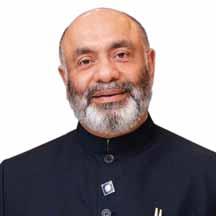
RC Panaji, RID 3170
Ina push for water conservation, 10 recycling facilities (STP units) will be installed at government hospitals and defence cantonments by tying up with a Japanese and an Indian firm. “The Jal Shakti ministry has okayed the project, a mix of global grant and CSR funding, the latter accounting for 60 per cent of $100,000 per unit. The water recycling unit can be upgraded further,” says Gaurish Dhond.
The district will add eight new clubs, four already formed, to raise the tally to 143. “We aim at a net membership growth of 1,000 to push up our strength to 6,700plus.” A mother’s milk bank (GG: $100,000) will be set up by RC Seven Hills Dharwad for those who can’t nurse their babies.
Under the Ujjwal Drishti Abhiyan , Dharward clubs screened over 33,000 children for eye disorders and free spectacles were given under the GoI’s Vision India programme. “We tied up with the Goa government to build 32 houses ( ` 5 lakh each) for flood victims. In the first phase, five houses are under construction. While ` 2 lakh comes as government subsidy, the rest is raised through club funding.” The paediatric department at the Goa Medical College Hospital is being upgraded (GG: $60,000). For TRF, his target is $1 million. Dhond has been into social work as a member of Round Table India. “I had many Rotary friends in Bengaluru then. As one can’t be a Round Tabler after 40, I joined Rotary in 2000.” He is the chairman of the Goa chapter of the Indian Red Cross Society.
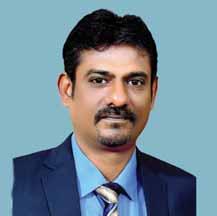
K
RC Quilon West, RID 3211
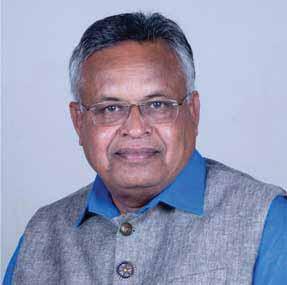
Automobile dealer
RC Gobi, RID 3203
‘Ente Gramam’ creates big impact A ` 60 crore-cancer hospital in pipeline
Each of the 150 clubs has taken up at least one village adoption programme in which many projects are being implemented under the district’s flagship Ente Gramam initiative. “Our village projects include building houses, providing equipment to PHCs and hospitals, revamping schools with facilities such as toilet blocks. The funds are raised through member contributions,” says K Srinivasan. In February, a project to build 10 houses ( ` 60 lakh) on 50 cents of land donated by the local MLA and a landowner was launched at Koottickal village, Kottayam. “The beneficiaries are those rendered homeless in the recent floods. In all, we will build 50 houses this year,” he says.
His target for TRF giving is $1 million. Six dialysis centres will come up at government and charitable hospitals through GGs, each valued at $36,000; while a blood bank will be set up in Kollam ($33,000). Recently, two hearing check-up camps were conducted in which 400 hearing aids were distributed. So far, 240 general health camps were held and “we will do 200 more in villages.” He is confident of adding 1,000 new members taking the strength to over 5,500. Fifteen new clubs, eight already formed, will take the total to 157. Having joined Rotary in 1991, influenced by his father’s friend Rtn PA Subramanian, the DG says, “ Ente Gramam will create growth opportunities for Rotary as our efforts in building village infrastructure have boosted our public image.”
Setting up a 400-bed Covid hospital within the premsies of the Government Hospital, Perundurai, in Erode in a record time of 45 days at ` 20 crore at the height of the pandemic is a model healthcare project which got high praise from RI President Shekhar Mehta.
As the maiden DG of the newly-carved district, Shanmugasundaram aims to form 20 new clubs to take up the tally to 103. “Our target is a net membership growth of 1,000, taking the strength to 5,000-plus by the year-end.” Two dialysis centres will come up at the Udumalpet GH and a private hospital in Tirupur (combined GG: ` 1.1 crore); a mobile heart-screening clinic will be flagged off by RC Tirupur Gandhinagar (GG: ` 1.5 crore) and “this fully-equipped bus will do angiogram and angioplasty for free.” A derelict 90-acre pond at Samalapur village was rejuvenated ( ` 2 crore) by RC Tirupur West.
His target for TRF giving is $1 million. RC Mettupalayam has developed a digital app ‘I Rotree’ with the help of Rotaractors. This app will record the number of trees planted by Rotarians across the world to maintain digital data. “The work on the ` 60 crore-cancer hospital at the Tirupur GH will begin soon under the mentorship of PDG Dr Muruganathan,” he says. He joined Rotary in 1985 influenced by charter member P Karuppanan. He hopes to complete all the 14 GG projects (directed gifts: $473,000) in time before he demits office.
Designed by N Krishnamurthy

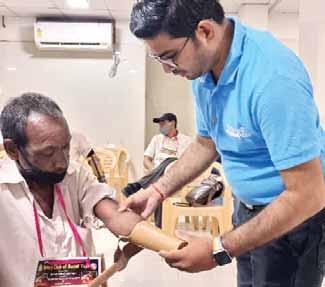
RC Pune Sports City, RID 3131, co-sponsored the Pusalkar Premier League, a tournament for Pune cricket clubs. The club set up a Rotary stall and a blood donation camp at the venue. RI Director Mahesh Kotbagi inaugurated the stall.
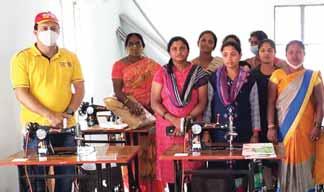
Rotary Club of Bangalore Lakeside, RID 3190, has set up the Rotary-Ashrita Training Centre to impart sewing and embroidery skills to 100 self-help group women from rural villages around Koira near Bengaluru.
RC Surat Tapi, RID 3054, with support from RC Jamnagar, RID 3060, organised an LN-4 hand fitment camp in Surat. About 77 people from various states benefitted from it.

TRF Trustee Aziz Memon presented Rotary’s five-year financial forecast at the Mahabs Rotary Institute. PRID PT Prabhakar chaired the session.
The Rotarians of RC Nagpur Black Gold, RID 3030, have given a new lease of life to used saris, transforming them into colourful cloth bags. “In one of our club meetings when we discussed ways to help women in villages to earn regular income so that they can support their families, club secretary Sheela Tai came up with this idea and we went ahead with it,” said Anil Mahalle, president-elect of the club.
Nagajhari, a village 35km from Nagpur, was chosen for the pilot project and the gram panchayat helped in identifying 12
enterprising women who were ready to take on the job. To begin with, each club member brought in five saris, neatly washed and ironed. Three members donated their sewing machines to the villagers and Sheela taught the women to stitch bags from the saris. “Over 100 bags were ready in no time. We then took them to the local vendors in Nagpur and sold each bag for `10,” said Mahalle. The vendors were happy to replace plastic bags with these cloth bags and used them to pack vegetables, fruits and other groceries for their customers. “We have identified more buyers for

the bags now. This valuable service has two sides — it provides women a means to earn a living, promotes an eco-friendly initiative and helps in discouraging use of polythene bags. More clubs can replicate this simple yet effective project in their communities,” he added.
The club plans to extend this economic empowerment project to more villages and is on the lookout for more sewing machines. An agreement has been signed recently with sewing machine manufacturer Singer to train underprivileged women in tailoring. “We have hired a hall and installed 14 sewing
machines costing `1.27 lakh. Singer will provide staff to train the women and issue diploma certificates which will help them get employment in textile firms.”
The six-year-old club is a couples’ club with 22 members and Mahalle aims to add 10 more couples during his year. The primary focus is on women’s empowerment and upgrading infrastructure in girls’ schools. “We have been renovating toilets, setting up handwash stations and sanitary pad vending machines in schools,” he said. The club also organises regular dental check-up camps in nearby schools.


Do you remember the saying, ‘A stitch in time saves nine’? Well, that stitch may also help the planet, make you feel good and help conserve resources. Luckily, there is no rocket science involved, just a periodic peek into the wardrobe and a few leaves from your grandparent’s book. They lived at a time when brands were few, fast fashion was unknown, and clothes were seen through a different lens.
In the previous issue, we read about the pollution caused by the textile and fashion industry, and its impact on climate change. But if we use our creativity and sensitivity more, we could control water usage and help lessen the chemicals and microplastics that find their way into the oceans.
And how would we do that? First, by not forgetting that we can sew. By simply threading a needle to fix the button that has fallen out, the pocket that has given way or the hem that has come unstuck. The simple act would prolong the life of a garment, prevent you from discarding it and help you to buy one less.
For the purpose of the article, I asked three youngsters, three middle-aged adults and a senior citizen what they do if their favourite garment develops a tear, its buttons fall off or its hem comes unstuck. Four gave me the same answer — that they condemn it to a corner of their wardrobe and forget about it. A waste no doubt. One said she gives it away, while the other followed an even more sustainable pattern. She piled up all the clothes that needed to be repaired and periodically, on the weekend mostly, called in a freelance tailor who fixed them all. The senior citizen repaired clothes herself, not only her own but that of other family members as well.
While all men and women may not be adept at stitching, calling in a tailor could be a great idea, especially at a time when most tailors are suffering joblessness due to the pandemic, and

Preeti Mehra
It’s not the big things, but the little ones that green the wardrobe.


your help could go a long way in providing employment. However, try to ensure that the tailor uses thread made from natural fibres. A lot of thread is wasted while sewing and the use of natural thread ensures it can be composted.
But of course, if you really want to throw away a garment as we often do, it wouldn’t take much time to pluck out the buttons, undo the lace, cut out the zip and save them to use on another dress. Discarded or shapeless garments that have no use any longer, when cut to size, make great dresses for babies and frocks, smocks, shirts and shorts for kids. You would be really saving the planet by putting the crucial three Rs into practice — refurbish, reuse and recycle.
Another peek in your wardrobe could throw up even more creative ideas. Men’s worn-out ties, for instance, make great piping for dresses, torn shirts can be refurbished into handkerchiefs and torn jeans into hardy work shorts. The idea is not to waste if we can help it. We must not allow textiles, which pump between 1.22 and 2.93 billion metric tonnes of carbon dioxide into the atmosphere every year and account for 6.7 per cent of all global greenhouse gas emissions, go to waste and pile up in landfills. And especially when, with a wee bit effort, they can be reused and recycled into new garments.
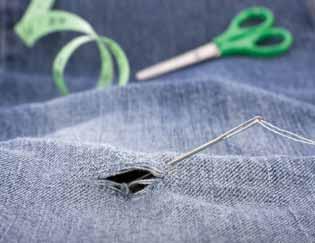
For those who just do not have the time to sew or get cloth refurbished, there is yet a third option — collect your giveaways and pass them to an organisation that is recycling for a purpose. NGO Goonj, for instance, collects clothes in any state — even rags — and fashion them in its factory into amazing tablemats, door mats and floor rugs. It sells these to raise funds for helping the homeless or victims of natural disasters.
their way to the secondhand market to cater to a different section of consumers. So, we do have a long tradition of recycling and not wasting, but in this digital, online shopping era we seem to have forgotten it.
Washing clothes also needs attention for a sustainable lifestyle. Try to use eco-friendly detergent, which several people are now formulating, and use a micro-mesh bag when washing. The bag will reduce the micro plastics released when washing. If you are laundering synthetic textiles, the bag will help capture the microfibres and prevent them from mixing with the water. It is estimated that almost 35 per cent of microplastics present in the oceans originate from the clothes we wear and the fabric we use. Fabrics and house accessories also have another story, but we will leave that for next time.
The writer is a senior journalist who writes on environmental issues
y
Talking of giving away old clothes reminds me of the tradition of exchanging clothes for steel utensils that exists in the country. I recall as a child being inquisitive when women came around our colony with steel plates, mugs, tumblers and tiffin boxes laden in baskets they carried on their heads. These would be exchanged for old clothes according to how many you gave them. As an adult when I became a journalist, I once followed their trail to find out that these clothes land up in a chindi bazaar, which exists in almost every town or city. The clothes were refurbished here, collars were turned inside out, pockets hid the blemishes, zari was repolished, and soon you had garments as good as new that made
ty. The clothes were refurre, collars were turned d , hid the e s, zari waas ed , an d u h a d as ew de

Mandatory requirements/guidelines for RF(I) contribution
Effective April 1, 2020, it is mandatory to provide PAN for all contributions made online/offline towards RF(I), irrespective of value or the donor’s intention to claim tax exemption under Section 80G of the Income Tax Act 1961.
Contribution credit and related 80G receipt can only be generated in the name of the remitter and is mailed to the donor on his email ID registered with RI.
For contribution made from self-owned/family-run company/trust account, donors are requested to share the corporate/trust letter made on the corporate/trust letterhead mentioning his/her relationship with the entity and state that the contribution be treated as his/ her personal contribution.
Club recognitions
TRF offers clubs several opportunities to earn recognition for their support of its grants and programmes. The Club Foundation Banner Report available in My Rotary, displays a club’s progress in the current Rotary year towards various club banners listed below:
100% Foundation Giving Club
100% Every Rotarian, Every Year Club
Top Three Per Capita in Annual Fund Giving
100% Paul Harris Society Club
100% Paul Harris Fellow Club (one-time banner)
As of 2015–16, new club members (those who joined or transferred from another club during the current Rotary year) are not included in participation requirements for club banners (except for the 100% Paul Harris Fellow banner). However, new members’ contributions will be used for per capita calculations.
Banner recipients listed in the Club Foundation Banner Report may fluctuate throughout the Rotary year due to changes in membership and additional or redistributed contributions. Final banner certification is processed by The Rotary Foundation following the close of the Rotary year on June 30. Club banners earned for the previous year are shipped to current DGs in October or November. You may request the District Foundation Banner Report at rotarysupportcenter@rotary.org. It is also available to club/ district leaders through their My Rotary login.
RI Director AS Venkatesh is Treasurer of Rotary International for 2022–23, when Jennifer Jones will be RI President.
RID Nicki Scott (England) will be the Vice President and RID Elizabeth Usovicz (Missouri, USA), the Executive Committee Chair.

Statement about ownership and other particulars about Rotary News to be published in the first issue of every year after the last day of February
1.Place of Publication:Chennai - 600 008
2.Periodicity of its publication:Monthly
3.Printer’s Name:PT Prabhakar Nationality:Indian Address:15, Sivasami Street Mylapore Chennai 600 004
4.Publisher’s Name:PT Prabhakar Nationality:Indian Address:15, Sivasami Street Mylapore Chennai 600 004
5.Editor’s Name:Rasheeda Bhagat Nationality:Indian Address:No. 25
Jayalakshmipuram 1st Street Nungambakkam Chennai - 600 034
6.Name and address of individual:Rotary News Trust who owns the newspaper and Dugar Towers, partner or shareholders 3rd Floor holding more than one percent 34, Marshalls Road of the total capitalEgmore Chennai - 600 008
I, PT Prabhakar, declare that the particulars given are true to the best of my knowledge and belief.
Chennai - 600 008sd/1st March, 2022PT Prabhakar
Here is Rtn Joe Prakash who cares for the welfare of disabled persons to such an extent that he has inspired his club, RC Tuticorin, RID 3212, in solemnising the marriage of such couples. “My club extends full support for the newly-weds to earn a decent income despite their physical limitations. We are ready to sponsor the marriage of 100 disabled couples,” says GP Joe Prakash, the club president. This service of the club has earned Rotary goodwill in this port city, in the southern part of Tamil Nadu. Due to the pandemic-induced lockdown, the 42-member club was unable to do “meaningful projects since January 2021. Most of us are over 50, and have our own enterprises to look after. But it struck me out of the blue one day that people with disabilities are the worst affected in this corona wave, and we, as Rotarians, have to do something to alleviate their sufferings,” says Prakash. On Jan 24, the club solemnised the marriage of D Robert and P Jeya, which was followed by another wedding between A Vijayaraja and M Kanagavalli on Jan 27. The newly-wed couples have access to limited resources and struggle to make both ends meet as their deformity makes life very difficult for them, says Prakash. “While Robert is an automobile painter, though he does not have fingers, and has some income, Vijayaraja needs support from us. We helped him get an eight-gram gold mangal sutra. The club will provide all home essentials to the couples.”
The club lets out its Rotary Roach Victoria Hall free of charge to disabled persons to hold their programmes and weekly gatherings. Built in 1946 with
V Muthukumaran
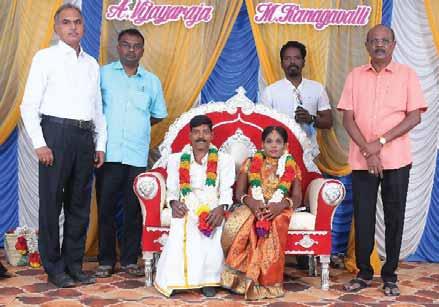
major contribution from John Motha, a Major Donor, the hall is named after PDG JLP Roach Victoria. It was renovated for the third time recently at a cost of `12 lakh. Apart from holding club meetings, events, “the showpiece hall is let out for social events, weddings and anniversary galas for which we charge `24,000 a day inclusive of all charges,” says Prakash.
A social activist Durai Pandi is helping the club to plan and chart out programmes for the disabled and marginalised families. He is organising a mega one-day event to mark Women’s Day in which transgenders, disabled women and mothers of special children will participate in a day-long gala consisting of variety entertainment, dance and musicals. “We expect around 250 women to turn up for the programmes. Fifty disabled women, transgenders, and frontline corona warriors (women) will be honoured,” says Pandi.
The club members visit Little Sisters of the Poor, an old age home, and St Joseph’s Orphanage at Adaikalapuram village on the outskirts to distribute monthly rations and donate cash for their expenses. Prakash also heads 4–5 trade, sports bodies such as the All India Chamber of Commerce and Industries, Tuticorin chapter; Tuticorin SIPCOT Industries Association; the local Gymkhana club; and the district chess association. “Through the job portal at the trade chamber, we hire disabled people for industries such as fuel retail outlets and other contract jobs.”
With the club on its platinum jubilee year, Prakash, a Major Donor, is toying with the idea of holding a celebratory event. Having been in the logistics business for over 35 years, he says, “everyday I network with my Rotarians and business associates to offer job placements to the disabled, whose skillsets are yet to be tapped by industry bodies.”
Your heart is racing, you feel a bit nauseous and lightheaded. Your breathing is shallow. You’re waiting to give your presentation and wishing you had never agreed to do it. Is this familiar to you? This and many other such moments which may produce similar symptoms of anxiety and stress are part of our daily lives.
‘Stress’ is a general term used to describe anything that causes a disruption of our equanimity and internal homeostasis. The term was coined by Hans Selye, a Hungarian physician, about 50 years ago. He later described what is commonly referred to as the ‘general adaptation response’, the response of the body to demands placed upon it. Stress induces bodily responses to the hormones such as cortisol, adrenalin and norepinephrine released during a stressful event/stimulus. Over time, if chronic and unresolved stress persists, these hormonal changes followed by the body’s physiological response can lead to ulcers, high blood pressure, arteriosclerosis, arthritis, depression, autoimmune disorders and allergic reactions.
There are varying degrees of stress — from mild anxiety before giving a presentation to acute stress during and following a car crash, loss of a loved one, loss of job, divorce or moving house.
person/behaviour, an event or even just your own thoughts. The ‘stress response’ is your body’s physiological response to the hormones released during stress and the symptoms you feel during that time. It is hardwired in us and causes a cascade of changes in our body like a racing heart, shallow breathing and sweaty palms.
The ‘fight/flight/freeze’ response is our behavioural response to the stressor. We may either move away from the stressful experience, or stand and get aggressive or we may freeze, unable to respond. There is no such thing as a stress-free life. We will all be faced with stressful events to varying degrees throughout our lives.

What is stressful for one person may not be so for another. You may find your work environment or public speaking stressful while someone else may not. So it is highly individual and often dependent on your tolerance for pressure and ability to manage it.
The ‘stressor’ is the event which causes the stress. It may be another
Some stress is necessary and even important. Too little stress leads to boredom. In fact, the right amount of stress can help us grow, challenge us and keep us engaged and focused. Some people are able to grow from their stress leading to what is called post-traumatic growth. In the short term,
stress hormones improve our immunity, motivation, cognition, focus and drive. The problems begin when we are faced with unrelenting stress, especially when unresolved in the background. Ill health, poverty, trauma, death etc are often beyond our control and causes of great stress.
However, many of the stressors in our modern-day lives are created by the way society is constructed and our response to it. Think, for instance, of our definition of success (money, name, fame) and societal pressure to achieve this success, consumerism, our need for more material stuff, pleasing people, constant comparison to others and our sense of not being enough… these and many more such perceived demands placed on us are unnecessary stressors that are self-created.
The first thing to do to manage stress is recognise it and differentiate between the stress that is good for you, that which is unnecessary and that which is beyond your control. The stress you feel before



a deadline, an important meeting or presentation can be the driving force to better performance. Even the stress from a painful event can be embraced as a stimulus for change and growth.
The next thing to do is articulate clearly the exact emotion you are feeling. Stress is a very general and vague word that is often misused. When you say ‘I’m stressed at work”, if you think more deeply about it you may want to rephrase that as, ‘I am disappointed and not satisfied at work’. This careful articulation of your emotions can help you deal better with the real problem in the long term.
To manage the immediate stress response (the racing heart, anxiety etc), breath is the key. These symptoms are the result of your sympathetic nervous system being stimulated causing arousal. Learning appropriate breathing techniques can help alleviate these unpleasant symptoms almost instantly. Your breath controls your nervous system. Breathing the right way will help stimulate the para-sympathetic nervous system which calms you down.

The term ‘“relaxation response’ was coined by Dr Herbert Benson, cardiologist and founder of Harvard’s Mind/ Body Medical Institute. The response is defined as your personal ability to encourage your body to release chemicals that signals your brain to make your muscles relax, slow the heart and increase blood flow to the brain.
His studies in the 1960s and 1970s showed that meditation promotes better health, especially in individuals with high blood pressure. People who meditate regularly experience lower stress levels, increased wellbeing, and a lower resting heart rate. The relaxation response is essentially the opposite reaction to the ‘fight or flight’ stress response.
There are many methods to elicit the relaxation response including breathing, visualisation, progressive muscle
relaxation, acupuncture, massage, breathing techniques, prayer, meditation, tai chi, qi gong, and yoga, chanting or prayer.
Breathing exercise is the fastest way to control the physiological response to stress. Here are four simple breathing techniques you can choose from:
Deep inhale and exhale – Breathe deeply through the nose and exhale through pursed lips. Repeat several times.
Alternate nostril breathing –
Practised in yoga and called Nadi Sodhan, this method involves using your ring finger and thumb to close alternate nostrils as you breathe in through the left nostril, close that nostril and breathe out through the right nostril. Next, alternate by breathing in through the right nostril and out through the left.
Double inhale - otherwise called physiological sigh is a two quick inhales (without an exhale in between) followed by a long exhale. Long exhales or the 4-7-8 breathing popularised by Dr Andrew Weil — breath in for a count of 4, hold the breath for a count of 7 and exhale for a count of 8.
In the long term, managing stress and facing life with equanimity requires many things.
— Regular breathing practices (even twice a day for 5 minutes helps)
— Meditation - Use an app like Calm or Mindspace to begin with if you want to be initiated into meditation. Regular (even short) practice is important to reap the benefits of meditation.
— Non-sleep deep rest (NSDR): Practices like Yoga Nidra fall under the category of NSDR. This is a guided meditation (you can find on YouTube) that will help you to relax deeply. It is a simple practice
that is exactly what it sounds like: you are not actually sleeping, but you are slowing down your thoughtflow and brain wave frequency, permitting your brain and body to rest deeply.
Dr Andrew Huberman, a neurobiologist at the Stanford School of Medicine, has come up with the term ‘non-sleep deep rest’ to describe these techniques that are scientifically proven to recharge your brain.
- Regular exercise — any form of exercise helps regulate stress on the long term. Consistency matters.
- Regular good quality sleep. 7–8 hours of good quality sleep is important for good mental health and managing stress.
- Changing your stress mindset. View stress as an opportunity for growth. Use it as a stepping board to challenge yourself.
-Improved social connectedness. Research has shown that when you have robust connections with other people who support you in life, stress is mitigated and more manageable.
While stress in life is a given, how you respond to its immediate effects and long-term consequences are not. Using your breath to control the immediate effects of stress can circumvent the unpleasant symptoms that are created by the stress hormones. Creating daily disciplines like exercise, meditation, breathing and sleep can help prime the parasympathetic nervous system to respond better to stress. The most important aspect of managing stress however could be your stress mindset which can actually create post-traumatic growth.
The author is a lifestyle medicine physician. sheela.nambiar@gmail.com www.drsheelanambiar.com



HOUSTON, TEXAS, USA 4-8 JUNE 2022
Register today at convention.rotary.org




Rotary at a glance

Rotary clubs : 36,754
Rotaract clubs :10,934
Interact clubs :17,067
RCCs :12,061
Rotary members: 1,191,822
Rotaract members:239,329
Interact members:392,541 As on February 22, 2022 AT




Sandhya Rao
When more than half the boys in a PG Business Communication class choose the romance genre for a reading-related assignment, something’s on the happen.
Wwe were in college. And recently, a highly erudite fellow book clubber confessed to having a soft-soft spot for romantic novels. In her words: ‘Not many people can reconcile to the fact that people can read serious creative stuff along with historical romance brain candy.’
At my students’ age I was more of an Edgar Wallace, Agatha Christie, Georgette Heyer, Zane Grey, Lobsang Rampa fan. Chicklit has never been my thing and I only read one Chetan Bhagat out of curiosity (although he’s justifiably popular and has expanded his repertoire considerably). I find it hard to plough through lovey-dovey yarns despite poring over my mother’s copies of Women’s Weekly’s short stories at age 11–12. I have not felt the urge to dip into Fifty Shades of Grey by E L James, but in my defence, I have read, with interest in college, Lolita by Vladimir Nabokov as also Lady Chatterley’s Lover by DH Lawrence.
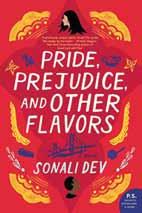
month’s booklist, then, is a tribute to my students, especially to those who may — hopefully just may — have come down with a case of readingitis, however mild.
Andaleeb Wajid was my first choice. I had been fascinated by the name, Andaleeb, when I first saw her short stories in the Deccan Herald many years ago. (The name means nightingale, apparently.) Then, a few years ago, I chanced upon More Than Just Biryani, and enjoyed it. This Bangalore-based writer has more than 25 books to her credit, covering many genres. Her favourite, she’s said in an interview, is romance.

e relate to these stories, said one young man. I feel like he’s telling my story, said another. Easy read, said a third. But there are also layers, clarified a fourth, it’s not so simple. And it flows with feelings, said a young woman. Listen, I love romance, said my friend, my age. Unabashedly. And another friend, my age, a feminist and women’s studies professor who has written several academic books that escape my comprehension entirely, has read practically every single Mills&Boon in Raviraj Lending Library, T Nagar, when


The two I picked were Twentynine Going on Thirty and All Drama No Queen, because they are connected — except that I read them in the wrong order because they were delivered that way! Priya stars in the first one, Fatima in the second. While they are primarily romances, there’s some intrigue going on as well, apart from a weaving in of other complicated relationships, not all to do with love-shove.

Given all this, you will understand my surprise at my students’ choices. However, what this communicated was that young people today feel a great need to be loved and to love, to feel wanted and needed and valued. It’s another matter that for many, this was the first book in any language they were reading — and that, for a bookaholic like myself, is puzzling in itself. This


Andaleeb Wajid writes lucidly and is clearly in touch with the world as we know it today. Tragically, she lost her husband and mother-in-law to the corona virus last year. Writing for Scroll. in about how writing is helping her through these dark times, she



Young people today feel a great need to be loved and to love, to feel wanted and needed and valued.





concludes: ‘As I scribble away in my notebook to plan the next book, I often look at my phone. The lock screen has a photo of my husband: a screenshot I took from a video of him driving, where he kept looking at me and making funny faces. I look at the photo a hundred times a day. Sometimes, I cry. Sometimes, I wonder why this happened. I rail at the unfairness of it all. And then, I get back to work.’
Readers may have seen the film, The Zoya Factor, featuring the delectable Dulquer Salman. Well, it’s based on a book by Anuja Chauhan, widely regarded as being among the best writers of popular fiction in India today (move over, whoever!). Her books are well researched, racy, pacy, and her characters are, well, characters alright! In fact, it would seem that all her novels are movie material. She is often described as one of the best writers of chicklit, to which an entry in Wikipedia claims she responds with: ‘Chicks are small, brainless, powerless creatures, bred to be eaten. I’m not a chick and I don’t write for chicks.’
Among my favourite books is her Battle for Bittora, a novel that authentically explores the dynamics of elections. Not surprising, considering that the Congress leader of long standing, Margaret Alva, is her mother-in-law. Anuja Chauhan writes fearlessly and vigorously, all the drama, even melodrama, in her writing never pushing the romance into the shadows.
For this month’s column, I read The Zoya Factor (far more intriguing than the film) and Baaz (totally gripping). What made Baaz even more fascinating was that the main action is set against the backdrop of the creation of Bangladesh in 1971. Coincidentally, I’ve been watching Jo Bicchar Gaye, a Pakistani serial about what they refer to as ‘the fall of Dhaka’, told from the (West) Pakistani perspective. Seeing something from different points of view is an education, always interesting, always insightful.





My friend who loves romance unabashedly pushed me to read Sonali Dev. This writer is a Jane Austen fan, so her books kind of pay homage to that writer. Some time ago, there was something called the Austen Project in which some of Jane Austen’s most famous novels were re-imagined by modern writers. These included Sense and
Sensibility by Joanna Trollope, Northanger Abbey by Val McDermid and Emma by Alexander McCall Smith. I must admit I
was not a fan of this project, and took my friend’s recco with some reservation. Sonali Dev’s list of published books is long, so I went with the first of a series about the Rajes, an immigrant family living in San Francisco: Pride, Prejudice and Other Flavours.
Once I started, I couldn’t put it down! I loved it and can’t wait to read the next books in the series, as well as some of her other books. The plot is engaging, the style is riveting, the characters are well put together, and best of all, the mileu is multicultural. The description on the back of the book says Sonali Dev ‘writes Bollywood-style love stories that let her explore issues faced by women around the world while still indulging her faith in happily-everafters’. In PPOF, the mom character is a former Bollywood actor. For Austen fans, here are the names of the books in this series that follow: Recipe for Persuasion, Incense and Sensibility, The Emma Project… ! Of course, these are just three names in a long and growing list of serious writers of romance. Which only goes to prove that in the final analysis, it doesn’t matter in whom we trust, or whether we cover our heads or not. We all want love. Romance, yes, but also the warm feeling that comes from feeling safe and secure and wanted. It comes from our world of family, friends and other animals, and all that we experience with them in all the things we do.
The columnist is a children’s writer and senior journalist



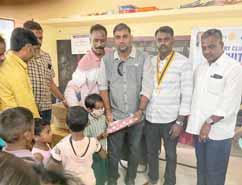
Notebooks and stationery items were donated to 130 students at the Boothurai Panchayat Union Primary School. The faculty thanked the club for the gesture.
Club president Rajnish Mittal donated 15 fetal Doppler machines to the Safdarjung Hospital to check the heartbeat of newborns.
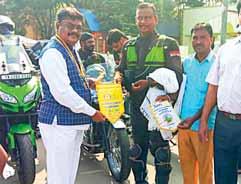
The club, along with RC Villupuram, organised a traffic awareness motor rally across seven RI districts (2,500km).


A tricycle was given to a physicallychallenged person. For many years, the club has been donating tricycles to such persons to help them take care of their basic needs.
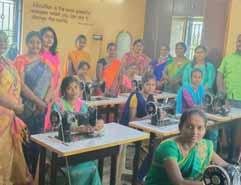
A tailoring training centre was inaugurated by Rtns Nilavathi Gopalakrishnan and Meena Subbiah. It was set up to train women in tailoring.
A mega blood donation camp was held in which 170 units of blood was collected by the Rotary Blood Bank.

RC Kashmir — RID 3070RC Kushinagar — RID 3120

School bags and stationery were distributed to children at the Rotary Asha Kiran Centre, Bandipora.
The club distributed 15,000 masks to people who visited a fair at the Buddha Main Gate in the city. Police officer Piyushkant Rai inaugurated the project.
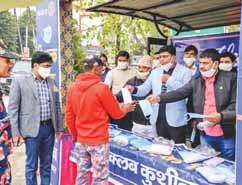
RC Kurukshetra — RID 3080RC Pune Karvenagar — RID 3131
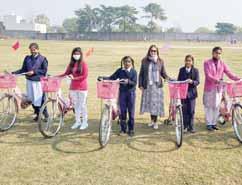
Bicycles were distributed to underprivileged girls for commuting to and from their schools. The cycles will reduce their travel time which will help them to focus more on their studies.
UV water purifiers were installed at 52 ZP schools (2,500 students) in remote villages of Bhor and Velhe taluks in Pune through a CSR project worth `14.56 lakh. DGND Shital Shah inaugurated one such unit.
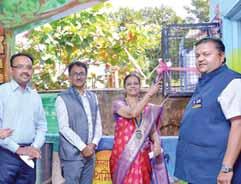
RC Meerut Umang — RID 3100RC New Bombay Seaside — RID 3142

A rainwater harvesting unit was installed at the Sreeram Saraswati Shishu Mandir in association with RC Meerut Unique and the Chandramohan Foundation. DG Rajiv Singhal was present.
Eight motorised ICU beds (`10 lakh) were donated to the Acharya Shri Naneshwar Hospital, Belapur. The project was funded by GN Hearing India.
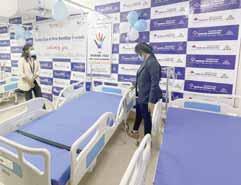

The club donated 60kg rice to a destitute woman living on the roadside and gave 50 plates to an orphanage school.
A dialysis unit was installed at the GH, through a GG and part funding by the Karnataka Bank. DG Ramachandra Murthy, IPDG Rajaram Bhat, and Sringeri legislator TD Rajegowda were present.
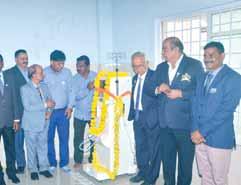

DG V Thirupathi Naidu inaugurated a municipal park, renovated at a cost of `5 lakh, in the presence of PDGs Surendra Bommireddy, Muni Girish and club president N Balakrishnam Raju.
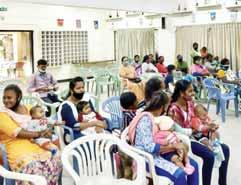
Under its twoyear project Healthy Mother Healthy Infant, 18 lactating and expectant mothers are being given nutrition kits on a monthly basis.
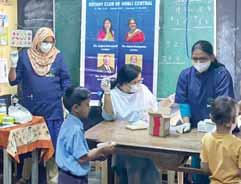
A dental camp was conducted by Rtn Dr Shruti Patil for 450 students at a government school in Nekar Nagar, Hubli.
The Great Thrissur Cyclothon saw a participation of 300 cyclists to create awareness on fitness regimen. It was inaugurated by DGN TR Vijayakumar.
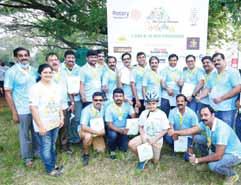
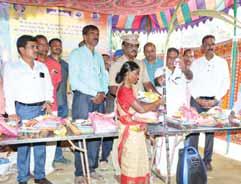
A gala Pongal festival at Sorandi hill near Athikkadavu village saw tribals taking part in games and musicals. Gift hampers worth `3.5 lakh were given to villagers.
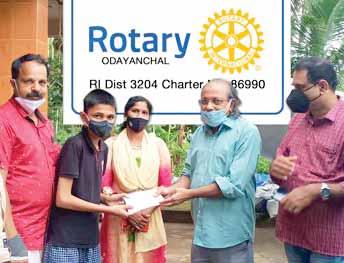
A financial assistance to the tune of `20,000 was given to MK Adarsh, a resident of Ayarote in Kasaragod district, for his treatment of Crohn’s disease.

The club donated sewing machines to the Alleppey Municipality to start a coaching centre for underprivileged women at Thathampally ward.
On the occasion of Pongal club president M N Manoharan gifted dresses, sweets and groceries to Ayyanar, a differently-abled person living on the outskirts of Sivakasi.

Sewing machines and ovens were donated to members of RCC Birkera following training workshops. Blankets were distributed to the beneficiaries.
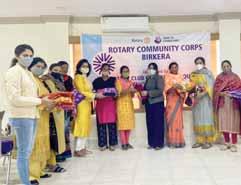
A medical camp was held at the Entally Academy with the support of Entally Saptasikha. Around 400 people were screened for ailments by Rotarian doctors.
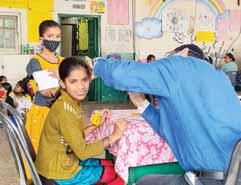
Compiled by V Muthukumaran
There used to be a time, a few decades ago, when most people saw a movie three or four times a year. This was because choice was very limited. People saw mostly movies with top class stars in them, never mind how bad those films were. But, on the plus side, going to the movies then was neither very expensive nor time consuming. Then in the 1990s came the multiplexes. The idea had been pioneered in Chennai as far back as the mid-1960s when Sapphire theatre had three halls — one for Tamil, the biggest; one for English, slightly smaller; and one — Blue Diamond — for miscellaneous films from elsewhere. This one was the smallest. You bought a ticket and stayed on for the whole day in it if you liked. It was very nice for young boys and girls looking for a bit of offcollege romance — less public than the Marina beach but public nevertheless. As in thousands of theatres all over the country, the ushers’ torches set the limits of romantic endeavour. The model was confined to Chennai as far as I know.
The advent of multiplexes made going to movies costly. One visit would set you back by anything between `1,000–1,500, depending on what all you ate while watching the film. So movie watching was a luxury. A family would usually see not
more than half a dozen films a year, even though the choice had expanded hugely. Individuals might see a dozen but that was all. Each one paid for his or her ticket.
Then, around 2000, came the satellite TV era and suddenly you could sit at home and watch a film at a much lower cost. But the channels were few in number, only a dozen or so. Most of them were free, which means very soon they had pretty much shown everything they had. If you watched three films a week, it meant 156 films. No channel had that many, and would rarely acquire new films. So in a few years the attractiveness of watching films on satellite TV also diminished. Even the huge explosion of movies-only regional language channels didn’t help. So for about a decade from 2010, after the boom of 2000–10, we were back to where we

had started from because the demand for films outstripped supply by a factor of 1,000. In any case, even though the films were nearly free, a TV set and a satellite dish were needed.
The whole game changed from around 2015. The coming of cheap smartphones and virtually free access to digital content had, by 2020, improved access in an unimaginable way, dropped costs and expanded supply to nearly infinity because you could watch subtitled films from all over the world. The rigours of the lockdown were greatly eased by the likes of Netflix, Disney-Hotstar and Amazon Prime. You could, if you so wished, watch 10 films a day even if in a fast forward mode that reduced the duration from an average of 100 minutes to just 60.
Multiplexes made going to movies costly. One visit would set you back by `1,000–1,500, depending on what you ate!
But a new problem has arisen. I forget what I had watched very quickly, within a month in fact, because I haven’t watched the whole film and even if I have, it is between doing other things, including watching a Test match, writing an article, talking on the phone, zooming and, very rarely, doing some housework. You may well ask, so what does your wife do? Well, she does exactly what I do — she watches the half that I have not watched. Try it, folks, it works as perfectly as the running between the wickets when Dhoni and Jadeja are at the crease.

Anoushka Jolly, a 13-year-old Class 8 student from the Pathways School, Gurgaon, has created a mobile app to stop bullying in school. She started this social venture in 2018 and created the Anti-Bullying Squad (ABS) app. With help of educational institutions, social organisations and experts, ABS has positively impacted over 2,000 students from over 100 schools and universities and received a `50 lakh funding offer from Shark Tank India, an entrepreneurial reality show.

Savji Dholakia, owner of Hari Krishna diamond company, who has been conferred with the Padma Shri Award recently donated a `50-crore chopper gifted to him by his family. The new chopper will be used for medical and other emergencies in Surat. He had made headlines earlier for rewarding his employees with cars, gold jewellery sets and two-bedroom flats as part of a loyalty programme.
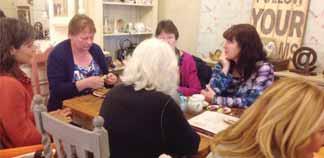

The National Centre for Polar and Ocean Research, which has been monitoring six glaciers in the Chandra basin in western Himalayas since 2013, has released a study that confirms that the Himalayan glaciers have lost ice 10 times more quickly over the last few decades. In the last 400 to 700 years, the glaciers have lost around 40 per cent area — shrinking from 28,000 sqkm to around 19,600 sqkm, with grim prospects of reduced water supply to millions of people in Asia.

In a bizarre incident reported from Beed district, Maharashtra, two enraged monkeys have reportedly killed close to 250 puppies. The killings began after an infant monkey was killed in the same region. Dubbed as “revenge”, the killing of the puppies forced local authorities to arrest the two monkeys who were carrying puppies to high-rise buildings and throwing them down.
The Death Cafe movement which started in London in 2011 has spread to 70 countries and completed over 10,000 death cafe meetings. The cafes are free and open to anyone who wants to talk about death. The cafes promote the discussion on death in a safe and supportive environment to increase awareness on the subject and help people cope with their loss. Tea, coffee and cake are on the house.
Registered No. TN/CCN/360/2021-2023
Licensed to post WPP No.TN/PMG(CCR)/WPP 431/21-23
Total number of pages in this monthly issue, including cover, 84. Price: `35
Registered with Registrar of News Papers for India 3880/57 Rotary News Published on the first week of every month
For several years, Rotary clubs not subscribing to a Rotary magazine or not paying magazine dues have frustrated the regional magazine managers. Non-subscription has a direct impact on sharing Rotary’s core messages.
After the RI Communications Committee’s deliberations on non-compliant clubs, at its November Board meet, RI has updated its rules for non-compliant clubs, which could now face termination. Existing rules and new ones:
Previous Process
The magazine office sends a report of non-compliant clubs to Rotary International.
Template letters from the district secretariat are shared with the magazine office, which then sends the letter to the appropriate clubs.










New Process beginning July 1, 2022



The magazine sends a report of non-compliant clubs to RI, clarifying if they are non-compliant due to non-payment - OR - not subscribing at all. Reports should be sent quarterly.
The magazine sends the letter to the clubs; Rotary will notify the District Governor with a separate letter.
The club has 120 days to comply or be suspended.The club has 90 days to comply or be suspended. If the club does not comply, the magazine sends a report to RI. Clubs are suspended.
Two weeks before the 90-day grace period, another reminder is sent to clubs still non-compliant. If the club does not comply, the magazine sends a report to RI. Clubs are suspended.
Process ended here.
For clubs that stay suspended and non-compliant for 180 days, another letter is to be sent stating “the Board at its discretion can terminate the club.”
Monitor club.
PETS & GETS curriculums will include information about mandatory subscriptions.
A threshold defining non-compliance will be determined: either 20% or 50% of club members?
Since this process will now be included in the Rotary Code of Policies, we hope to see better compliance. The Board of Directors to advocate for magazines in their zones. Directors were surprised to learn of the non-compliance of clubs, and that there are district governors and club presidents who are not aware of the mandatory subscription. That means Rotary must increase the messaging on mandatory subscriptions at PETS and GETS.
(For the information of our readers, the German regional magazine is delivered to over 65,000 Rotarians — almost 99 per cent of the total number. The rest subscribe to Rotary. In Japan, of the 85,000 members, 99 per cent subscribe to RotaryNo-Tomo; the remaining one per cent and many other Rotarians, subscribe to Rotary. In Switzerland and Liechtenstein — with 13,200 Rotarians in total — there’s only one club that doesn’t want to subscribe to any Rotary magazine. The local DGs are now solving that problem.)
Rotary News urges Rotary clubs in our zones to pay their subscription dues diligently. Message from Rotary International